HOSTED BY: 1 AIR TRAVEL
Long-haul, low-cost flights are a tricky business.
AirAsia, one of Asia’s largest and most successful discount carriers, attempted flights from Asia to London back in 2009, but eventually axed the route in 2012. Norwegian Air rapidly expanded its long-haul network (including flying between London and Asia) prior to the pandemic but a series of unfortunate events including Boeing 787 Dreamliner engine issues led to financial difficulties, and COVID-19 was the final nail in that airline’s long-haul coffin.
Norse Atlantic will attempt to pick up where Norwegian left off this summer, but its future remains to be seen.
Related: Norse Atlantic plans dirt-cheap transatlantic flights. Can it succeed?
One discount carrier has been quietly and cautiously growing its long-haul network, though: Singapore Airlines’ subsidiary, Scoot. The airline flies from its base at Singapore Changi Airport (SIN) to various cities in Asia and Australia. It also serves a few European destinations that Singapore Airlines does not, including Berlin Brandenburg Airport (BER) and Athens International Airport (ATH).
When the airline recently announced it would fly from Singapore to London’s Gatwick Airport (LGW) with a short stop in Bangkok’s Suvarnabhumi Airport (BKK) along the way, I was intrigued. Would this venture succeed where others have consistently failed?
I love an affordable flight, most recently having been impressed with EasyJet’s longest flight, and I really enjoyed Norwegian’s premium economy before the pandemic. But would the 15-hour journey on Scoot be like those flights, or would over half a day on a low-cost carrier simply be too much? Curious to find out, I purchased a ticket for my return to London from a friend’s wedding in Bali.
The experience left something to be desired … and that something was definitely not another long flight on Scoot! Here’s what the experience was like.
Get the latest points, miles and travel news by signing up for TPG’s free daily newsletter.

(Photo by Ben Smithson/The Points Guy)
In This Post
Booking
Scoot currently flies Boeing 787 Dreamliners from Singapore to London Gatwick via Bangkok twice per week, on Tuesdays and Sundays. The flight leaves Singapore at 7:20 a.m. for the two-hour hop to Bangkok, arriving at 8:35 a.m. local time.
After a 90-minute stop in the Thai capital, the aircraft then flies for nearly 12 1/2 hours, arriving in London at 5:30 p.m. Note that the timings and schedule of this new route change regularly.
One of the reasons I wanted to take this particular flight was that it takes place entirely during daylight hours. As I struggle to sleep longer than an hour at a time sitting up, I figured I could just stay awake for a full day, sleep in my own bed in London and hopefully beat jet lag completely. Landing in London just after midnight Singapore time meant I would spend an entire waking day on this flight.
Related: The best flights to ease jet lag when traveling to or from London
A great benefit of booking a carrier like this is that they usually sell one-way fares at half of the price of a return fare, whereas full-service airlines may charge a premium if you only fly one way.
I was pleased to see a one-way ScootPlus fare from Singapore to London for 1,054 Singapore dollars ($758) on Scoot’s website, though some days, fares are over $1,300 for this same route and fare class.
ScootPlus was previously known as ScootBiz, but rebranded in 2019 to reflect that it is much closer to a premium economy product than an international business experience (you won’t find any Champagne or private suites on this airline).
The cheapest seat-only fares on this route start from SG$646 ($465).
My ScootPlus fare included the following amenities and services that you’d have to purchase a la carte otherwise:
A larger seat in a dedicated cabin with more legroom and recline.30 kilograms (about 66 pounds) of checked luggage.Two pieces of cabin baggage (with a combined weight of no more than 15 kilograms (about 33 pounds).Preordered meals.30MB of Wi-Fi.In-seat power.If comparing this to premium economy on a full-service airline, Singapore Airlines charges $2,318 for the same one-way route, so this seemed like a great price. I was also able to select my seat in the small ScootPlus cabin at the front of the aircraft at no extra cost.
There was plenty of upselling during the booking process, too. I was advised that a full meal was included on both the short hop to Bangkok as well as the much longer flight to London. I decided to splurge on a Scoot Snooze Kit for SG$18 ($13) in case I did decide to take a quick nap. This included:
Polyester flannel blanket.Cloth-lined eye mask.Inflatable neck pillow.I realized 30MB of Wi-Fi wasn’t going to last long, so I pre-purchased the largest data pack available: an extra 200MB for SG$41 ($30). The pricing of this Wi-Fi would turn out to be a critical issue with my flight.
Members of Singapore Airlines’ KrisFlyer program can earn miles on this flight at a rate of 1 mile per Singapore dollar spent. The 1,054 miles I earned from the flight was not a large haul, worth just $13.70 at TPG’s current valuations. However, it was better than nothing, especially as KrisFlyer is one of my favorite Star Alliance loyalty programs, along with Air Canada’s Aeroplan. You can also redeem KrisFlyer miles for Scoot flights but please don’t as this is a terrible value — you will receive a fixed value of less than 0.7 cents per mile, far below TPG’s valuation of KrisFlyer miles.
Rather than redeeming 110,300 miles for this Scoot flight, save those miles for redemptions on Singapore Airlines’ fabulous premium cabins instead.
Ground experience
I grew up in Adelaide, Australia, when Singapore Airlines was one of the only international airlines flying to or from my home city. As a result, I have flown Singapore Airlines my entire life and passed through Changi Airport more times than I can remember.
Even after so many visits, it is still a joy to transit, and easy to see why it consistently ranks as one of the world’s best airports.
Aware of Scoot’s frustratingly strict 60-minute baggage drop deadline, I arrived at Terminal 1 just before 6 a.m. Even at that early hour, Changi was a hive of activity with multiple Scoot flights departing within a few hours of each other.

(Photo by Ben Smithson/The Points Guy)
Scoot has a sizable check-in area set up at its home base, with all passengers funneled into a single queue to check in at kiosks and then drop their own bags onto the luggage belts.
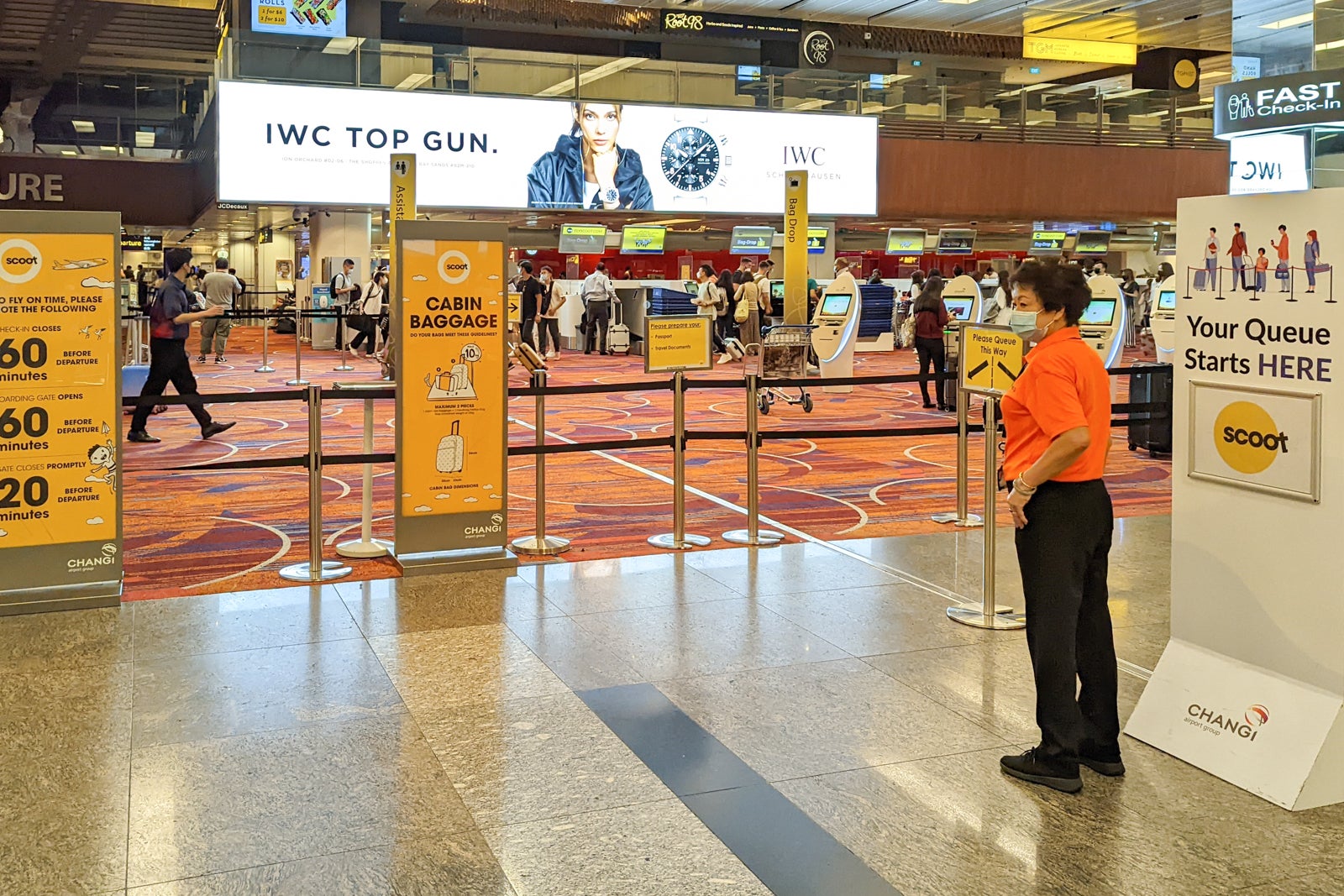
(Photo by Ben Smithson/The Points Guy)
There was no priority line for ScootPlus, but I only waited a few minutes in the general one with agents performing a quick check of vaccination certificates for certain destinations that require them, like Australia.
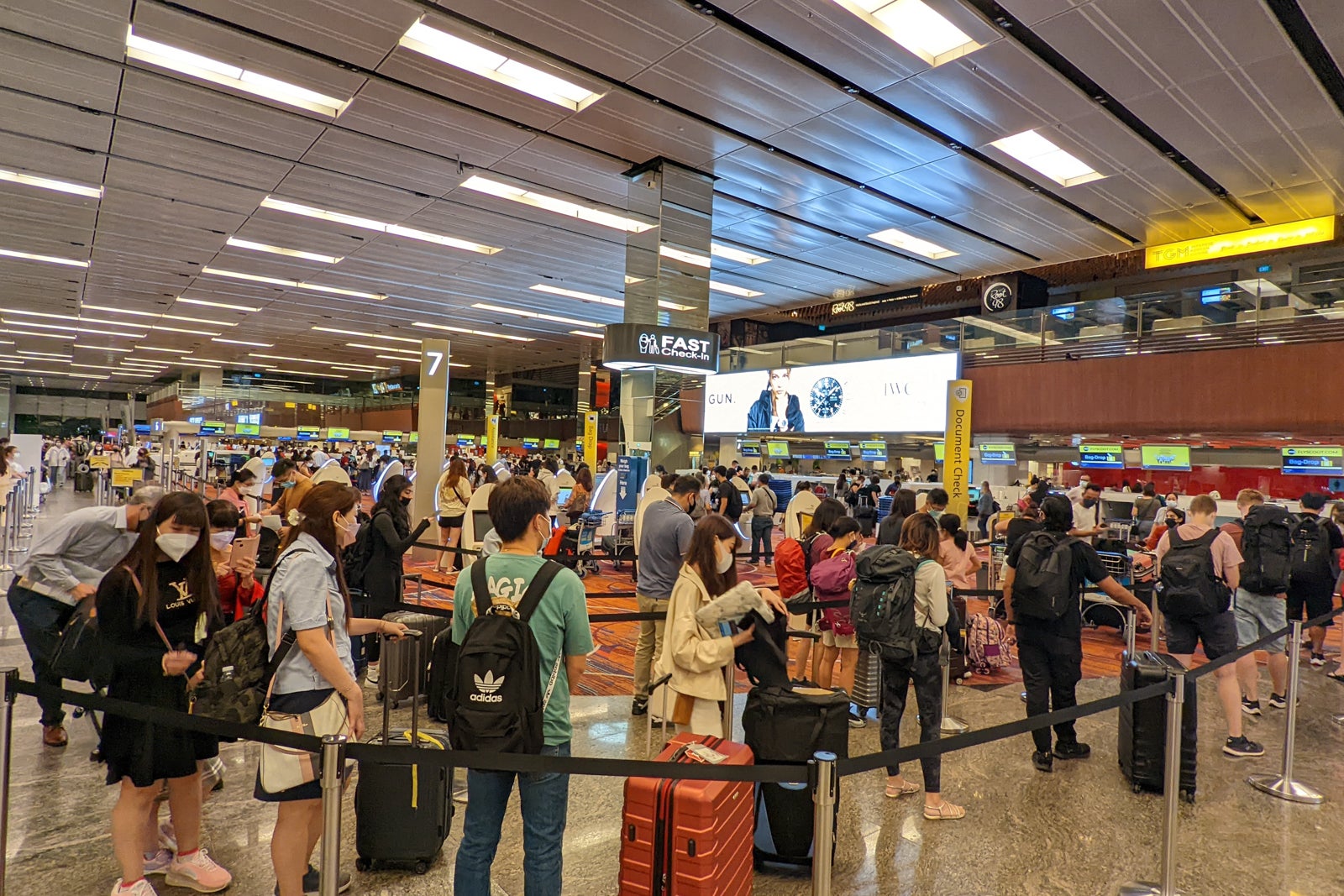
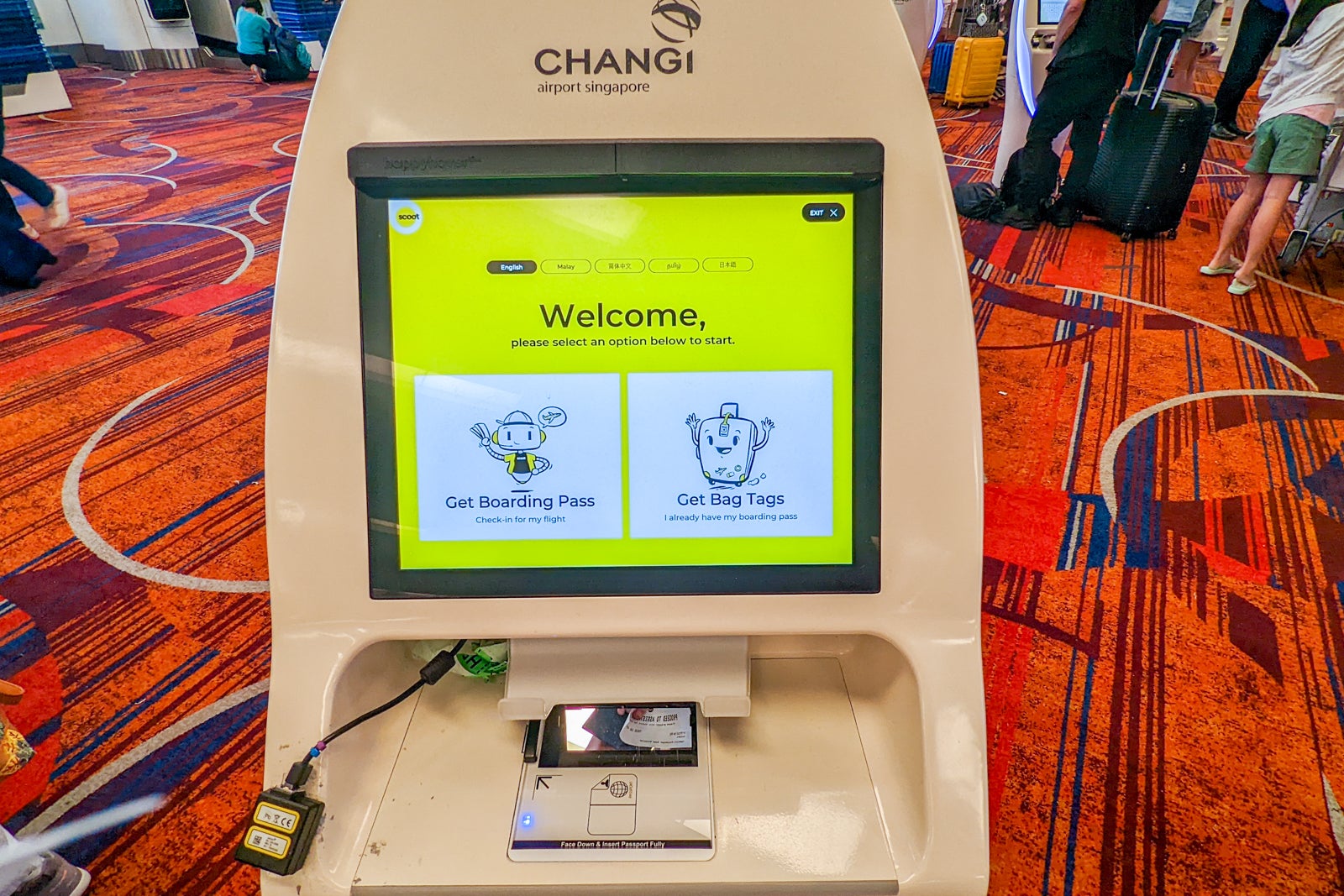
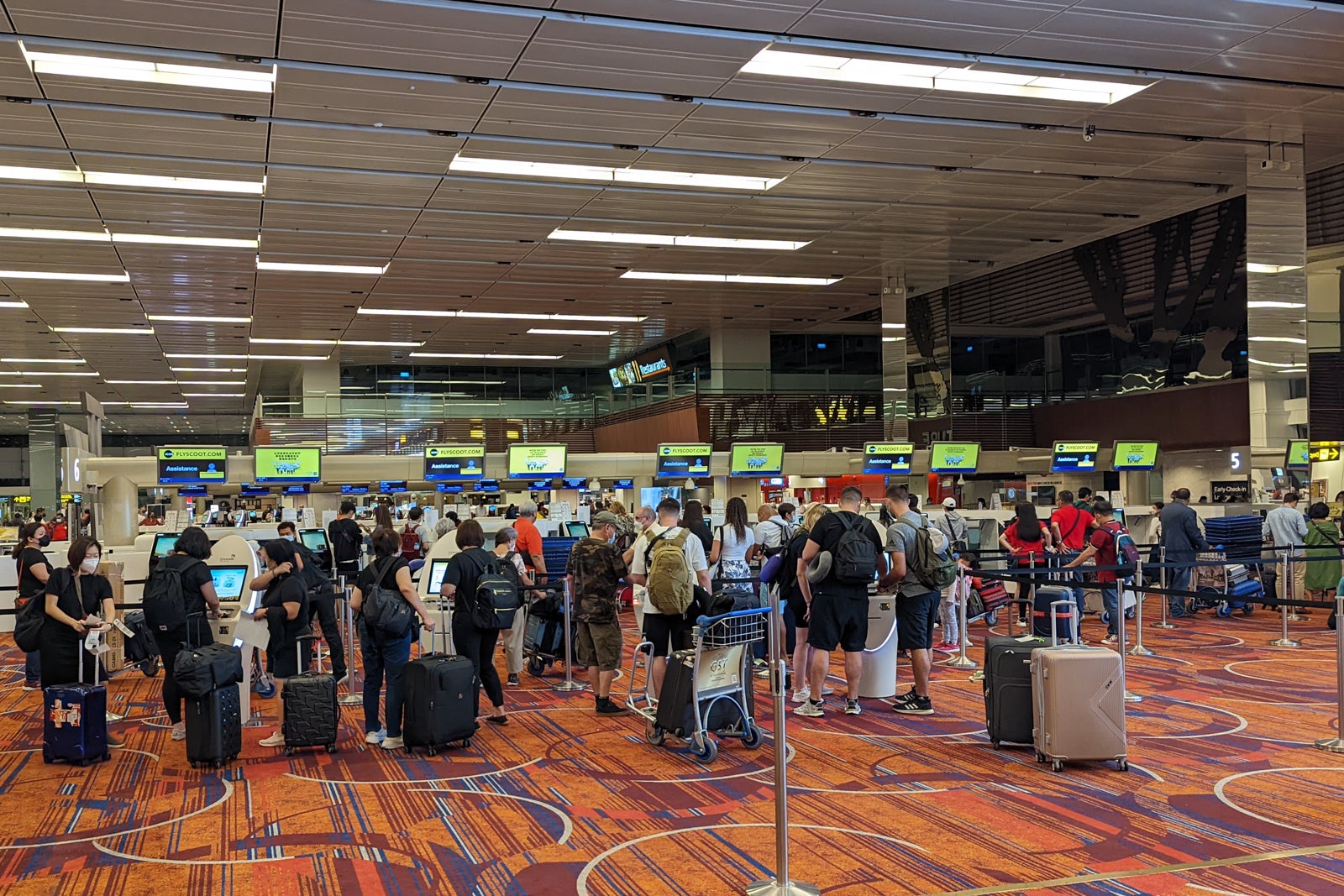
With my bag checked and my boarding pass printed I headed through the efficient and pleasant automatic passport control and into the airside section of Terminal 1 with its iconic carpet, reminiscent of what you might find in an aging casino. I was surprised to see many shops were shuttered at this early hour given that plenty of flights were departing.
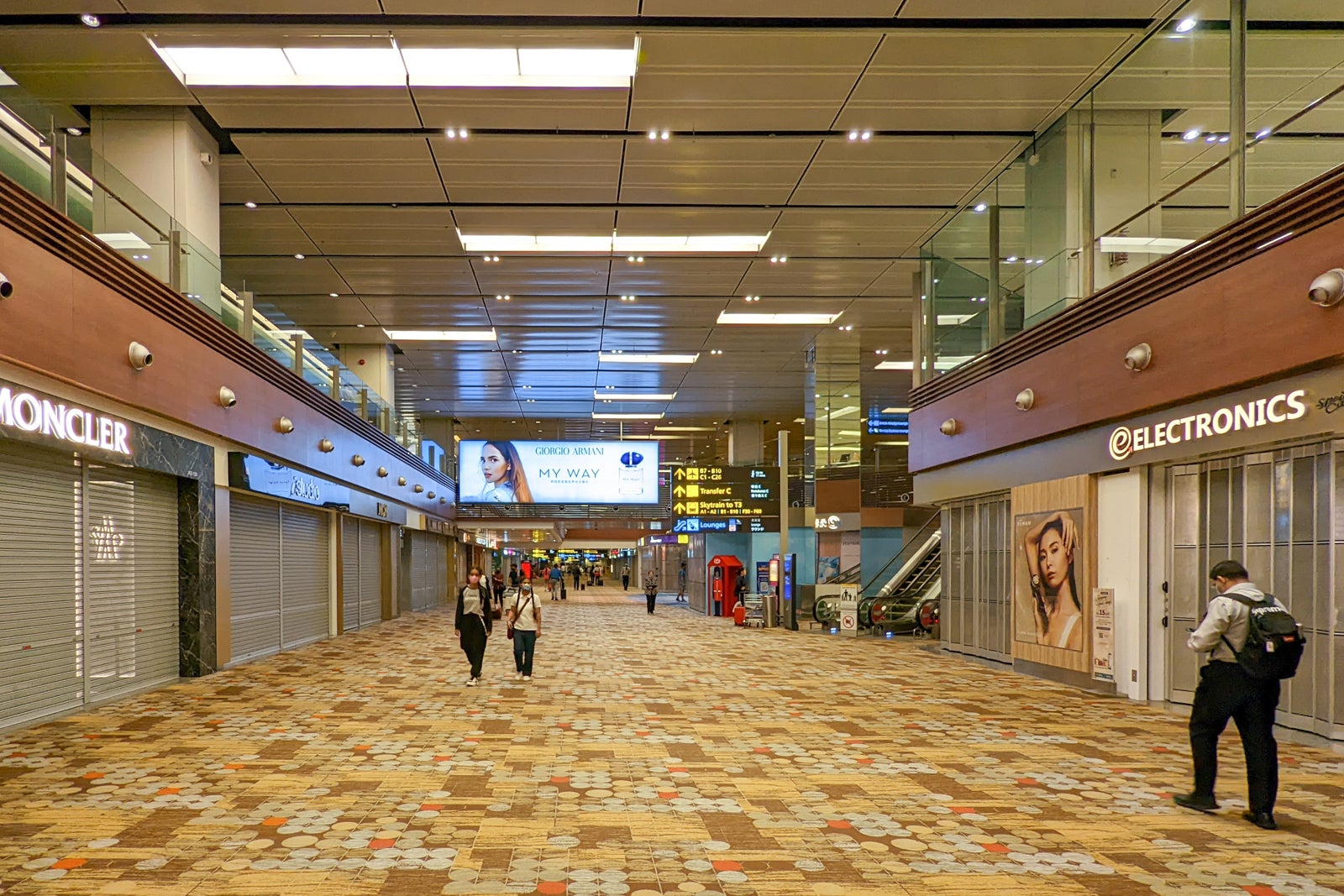
(Photo by Ben Smithson/The Points Guy)
ScootPlus does not include any lounge access, but I knew my Priority Pass membership gained me entry to some high-quality airport lounges. I chose the SATS Lounge, which was a modern and pleasant space to grab a quick morning coffee and a local pandan cake for a breakfast snack.
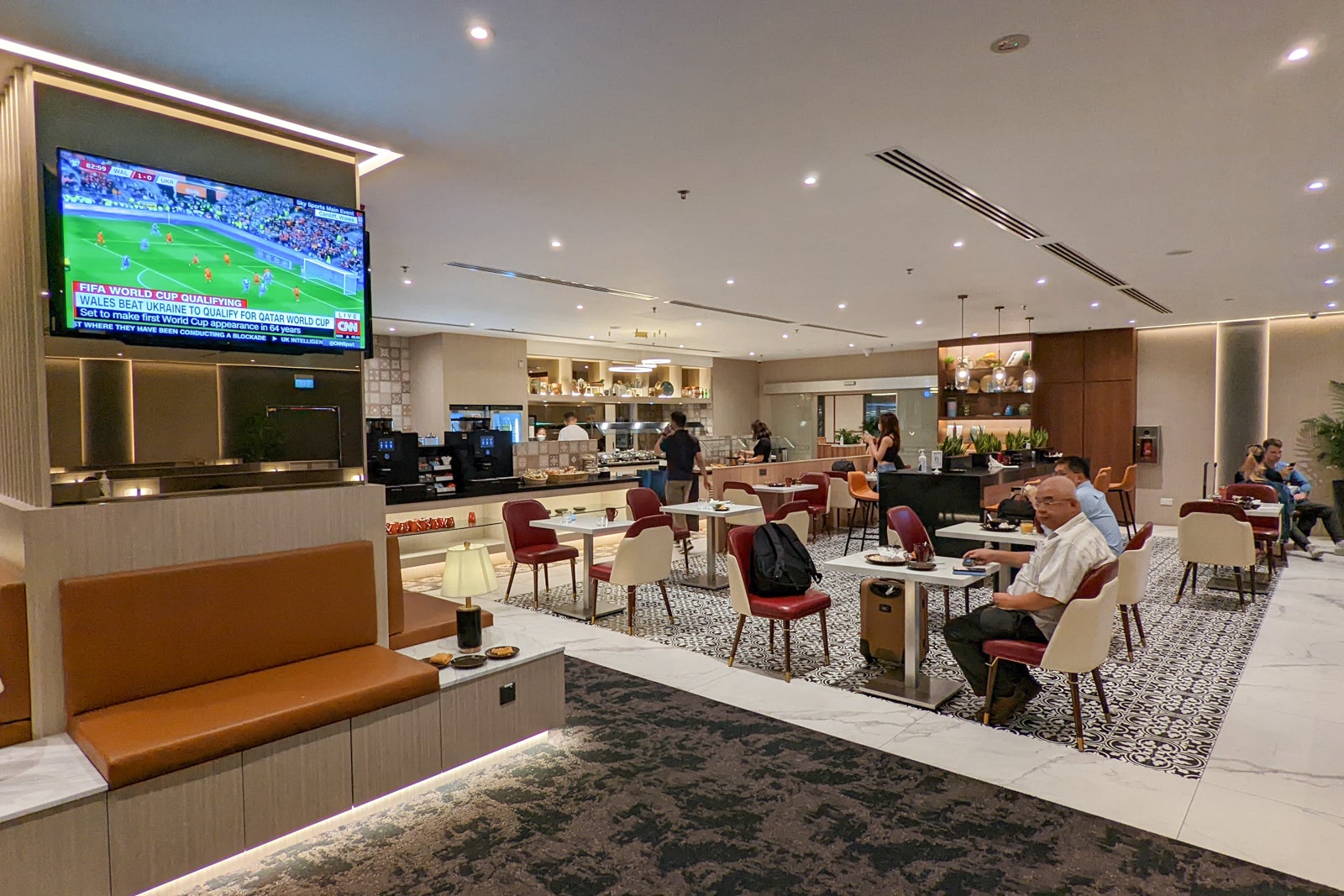
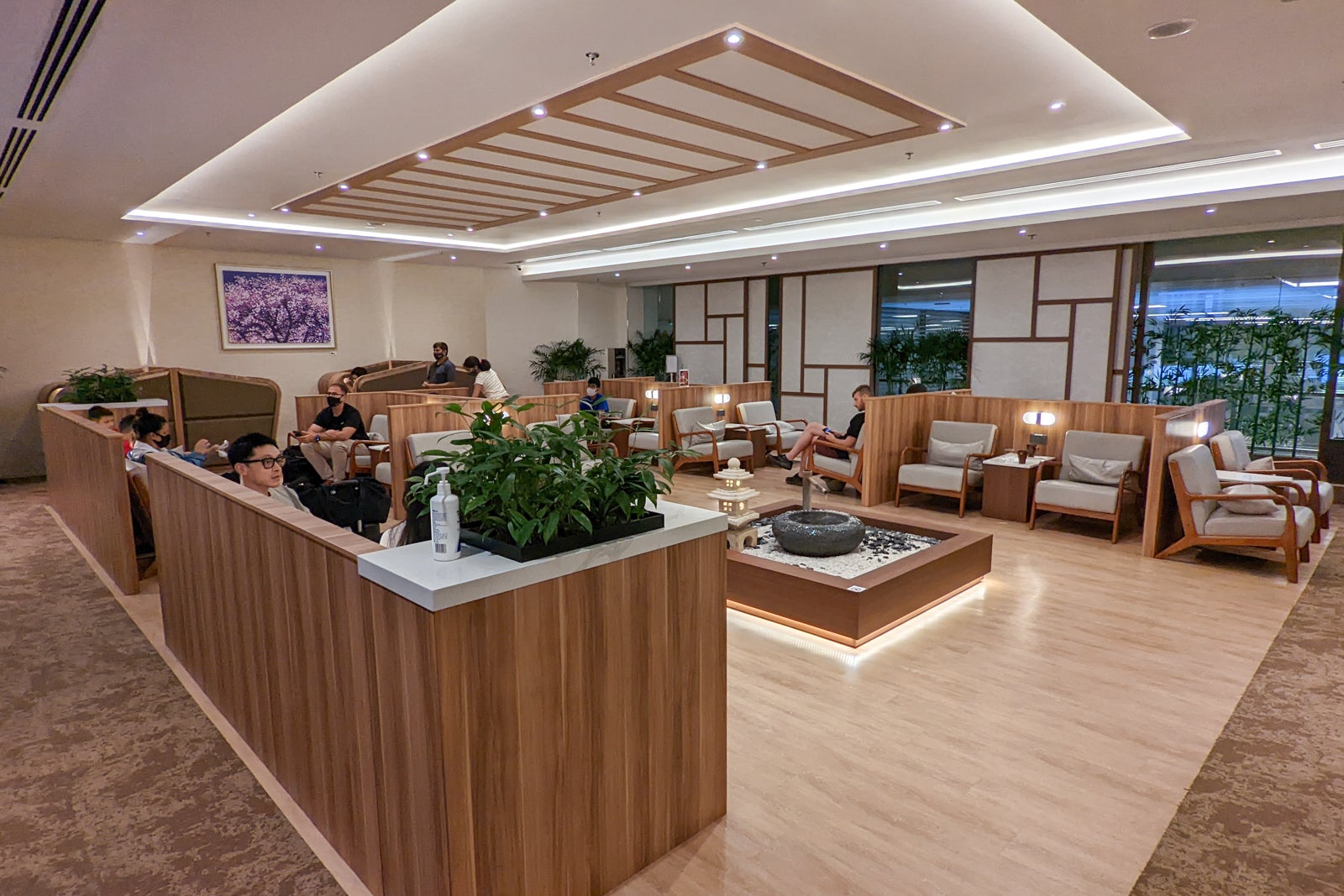
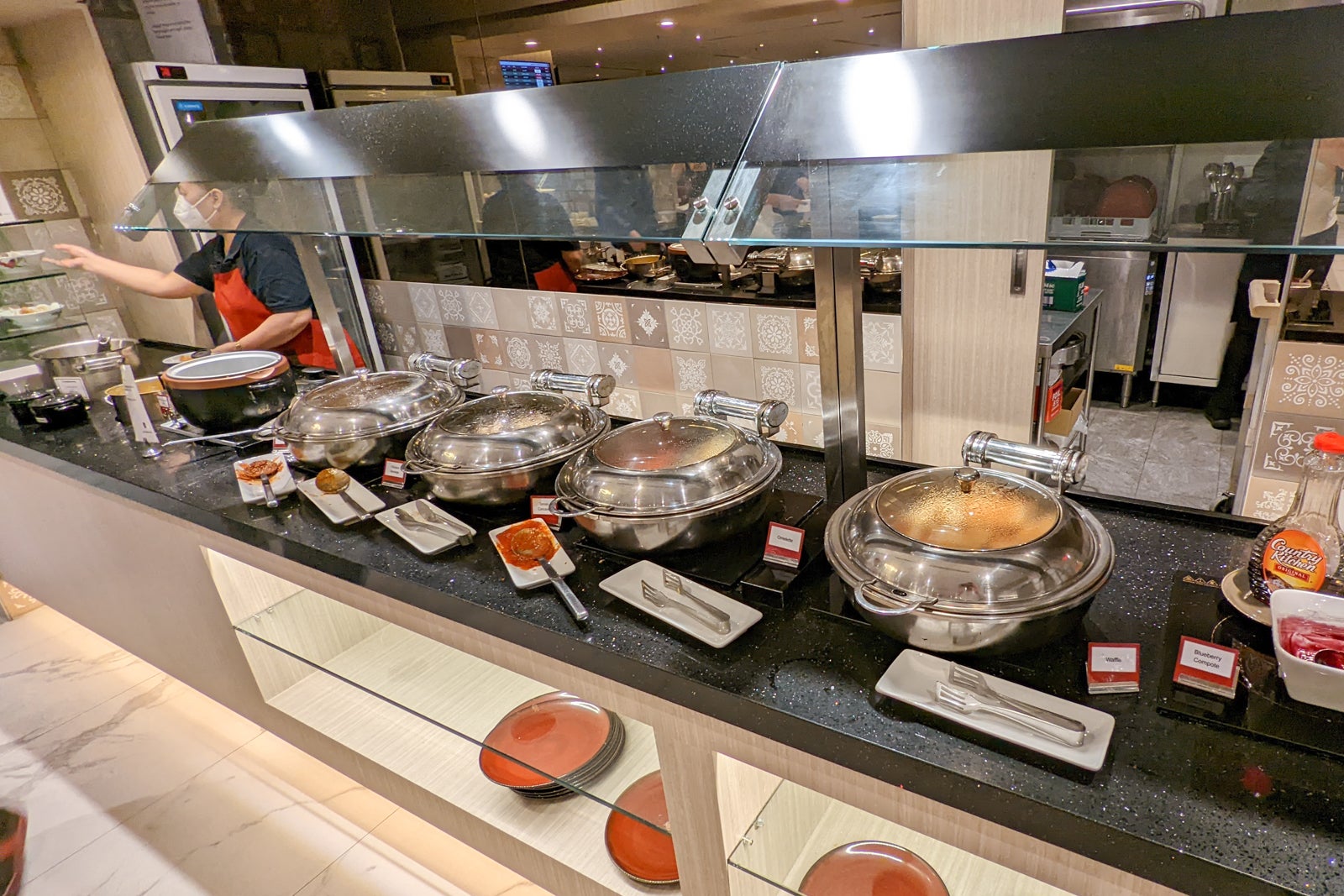
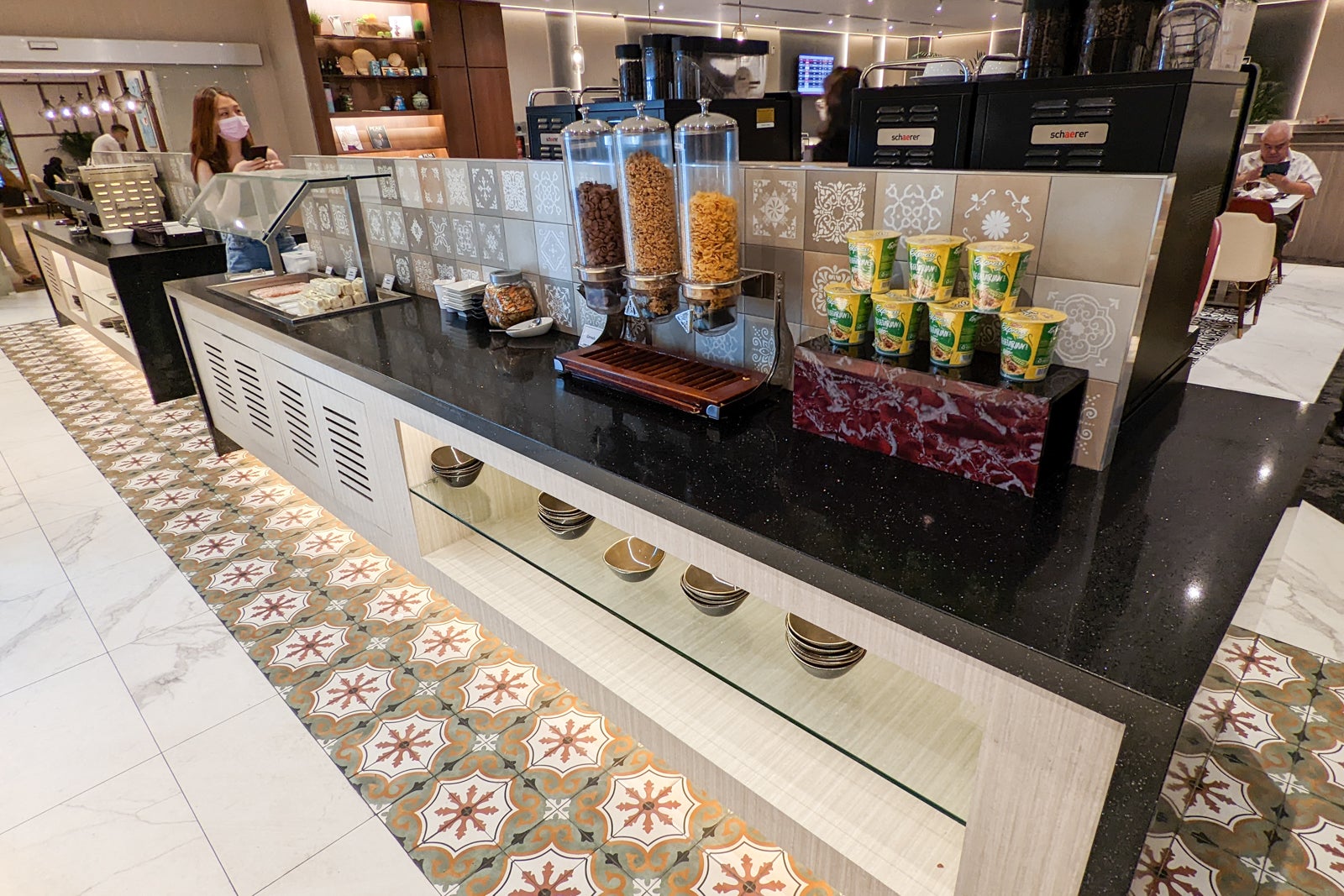
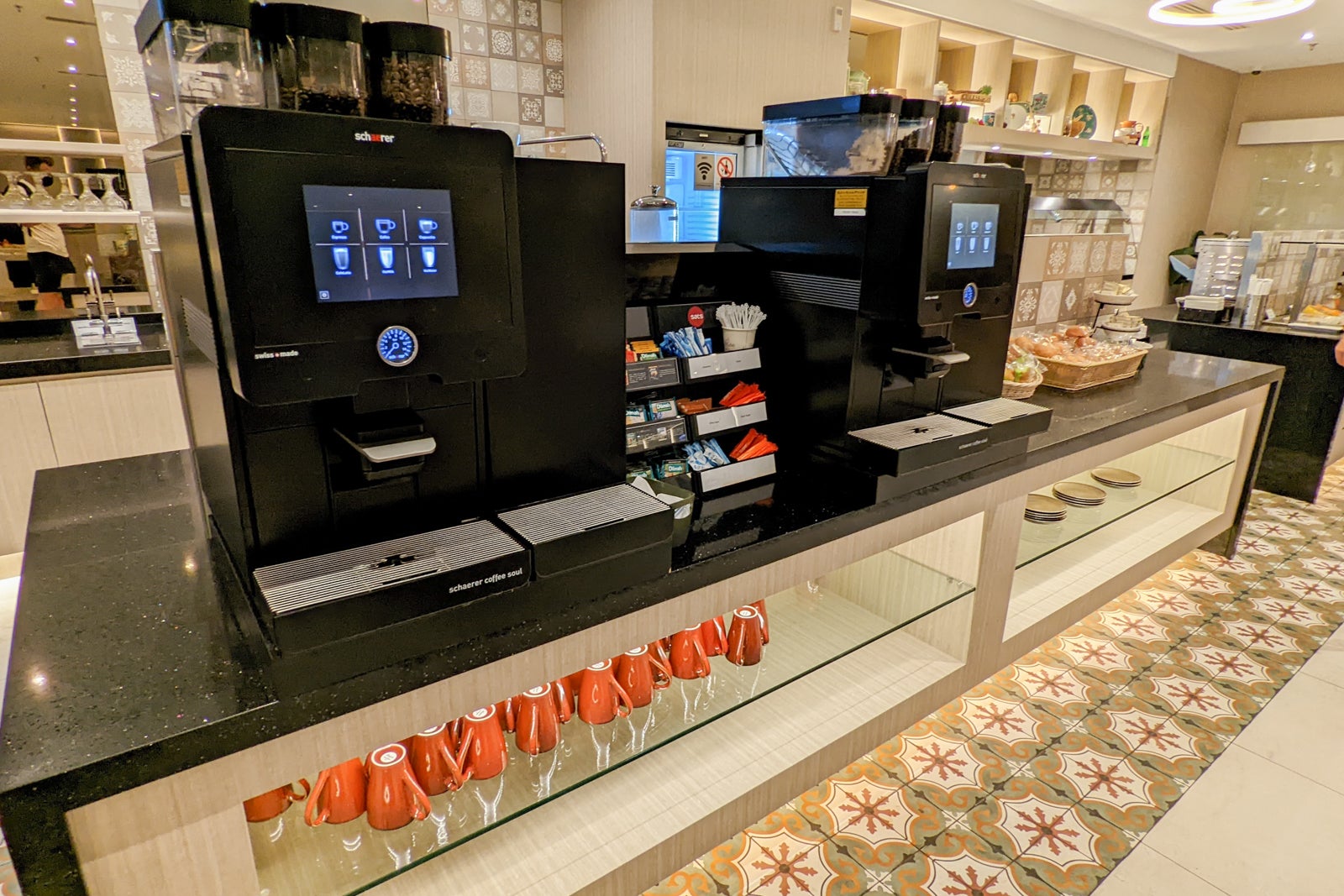
Security checks at Changi Airport occur at each individual gate, so allow some extra time before boarding to clear security. This also means you cannot take liquids to your gate. Fortunately, though, a water refill station was available at the gate, so you could refill empty bottles.
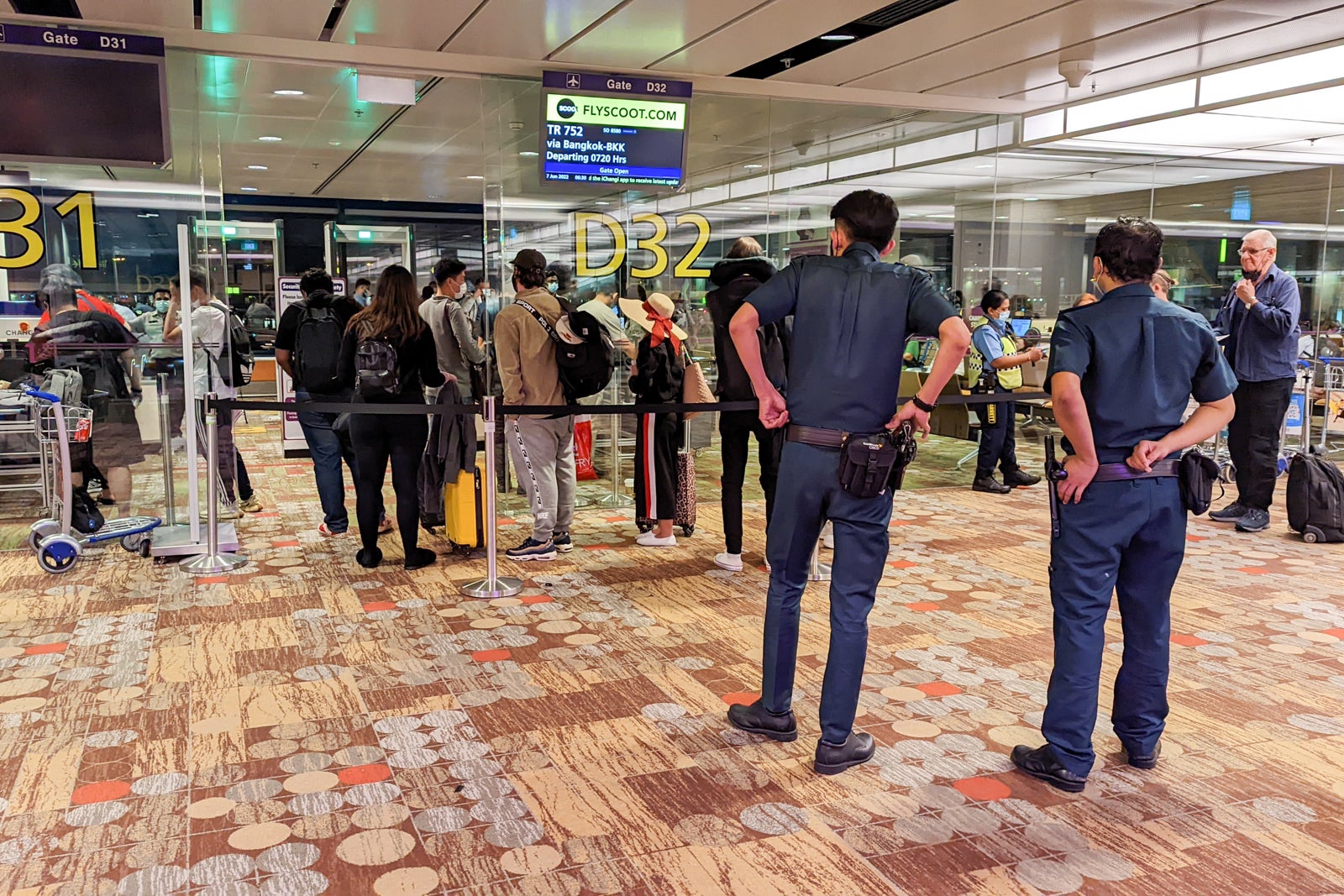
(Photo by Ben Smithson/The Points Guy)
Gate D32 was packed for the service to Bangkok and continuing on to London. Boarding commenced only 20 minutes before departure with ScootPlus passengers, families and those requiring some extra time being invited to board first.
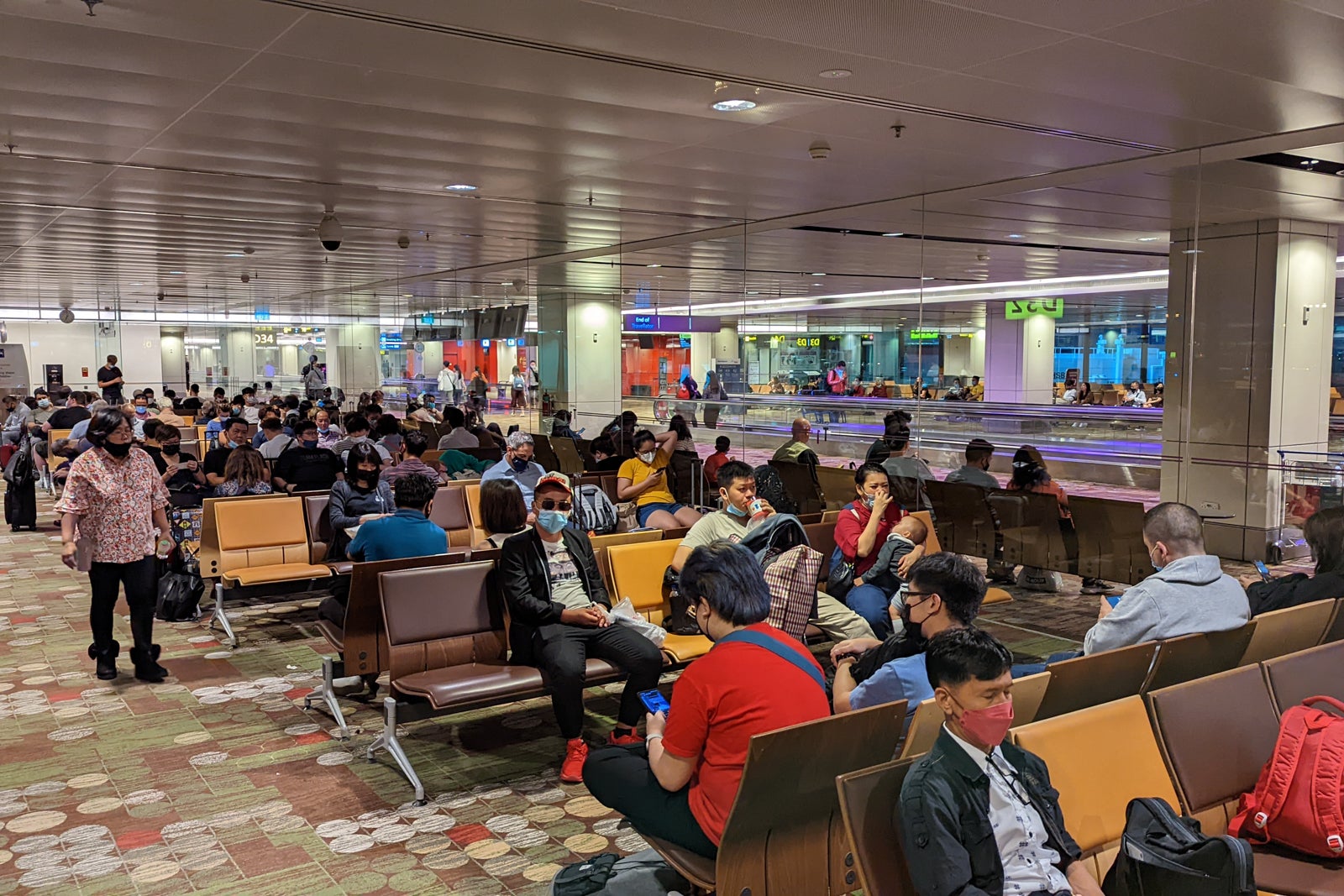
(Photo by Ben Smithson/The Points Guy)
Cabin and seat
Scoot squeezes a whopping 329 seats onto the Boeing 787-8 configuration I was flying. They are spread across three cabins, with 18 ScootPlus seats in a 2-3-2 configuration, 33 ScootinSilence extra-legroom quiet-cabin economy seats in a 3-3-3 configuration and 278 standard economy seats also in a 3-3-3 configuration behind that. My aircraft was 5 years old and delivered factory-fresh to Scoot.
By comparison, American Airlines has just 234 seats on the same aircraft type.
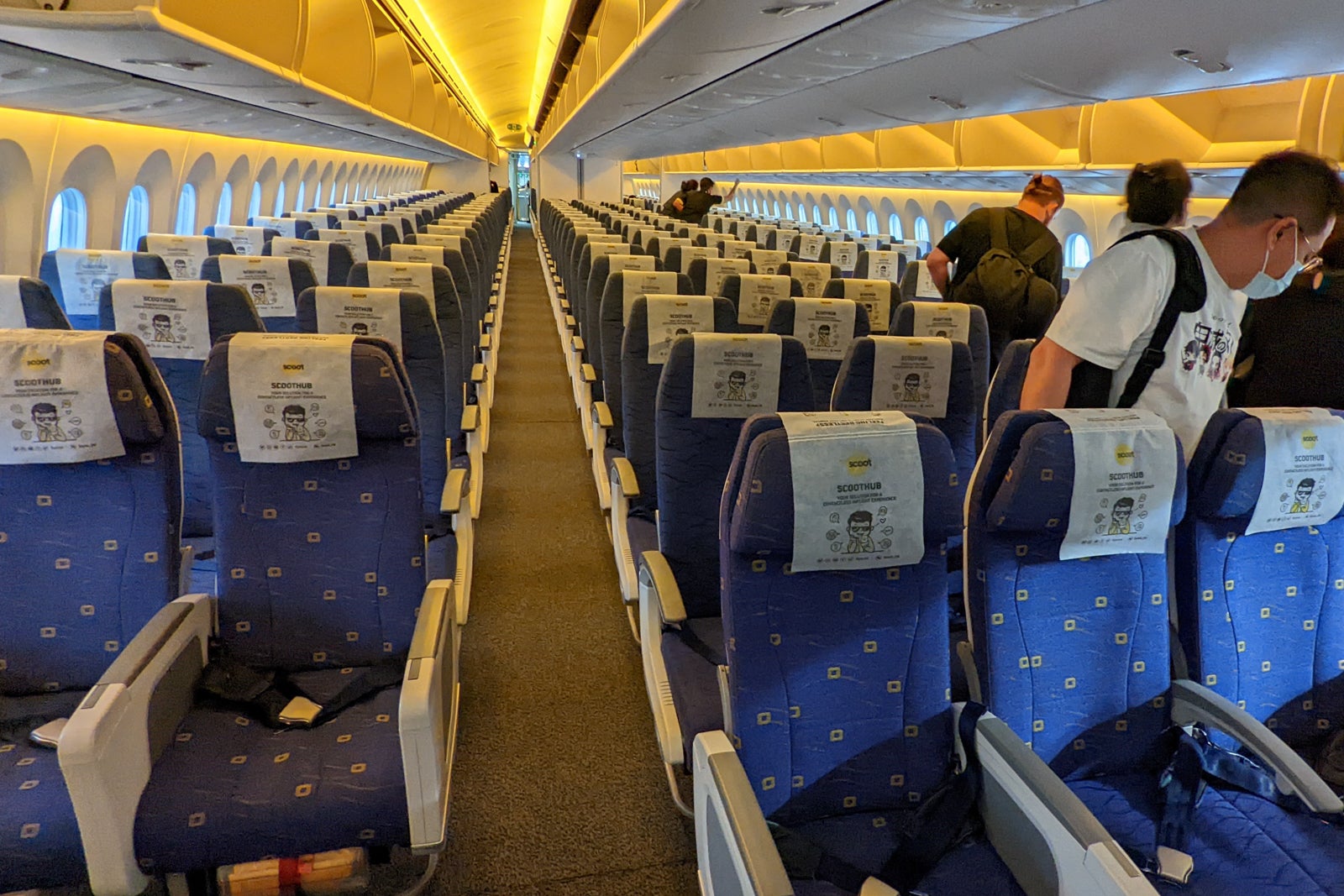
(Photo by Ben Smithson/The Points Guy)
My ScootPlus cabin felt tiny, with only three rows on the sides of the cabin and two rows in the middle. I’m surprised Scoot did not make a larger premium cabin given the length of these flights and that ScootPlus was 100% full on both sectors of my itinerary. The airline does operate 787-8s with a different configuration where there are three full center rows of three seats, for 21 ScootPlus seats total.
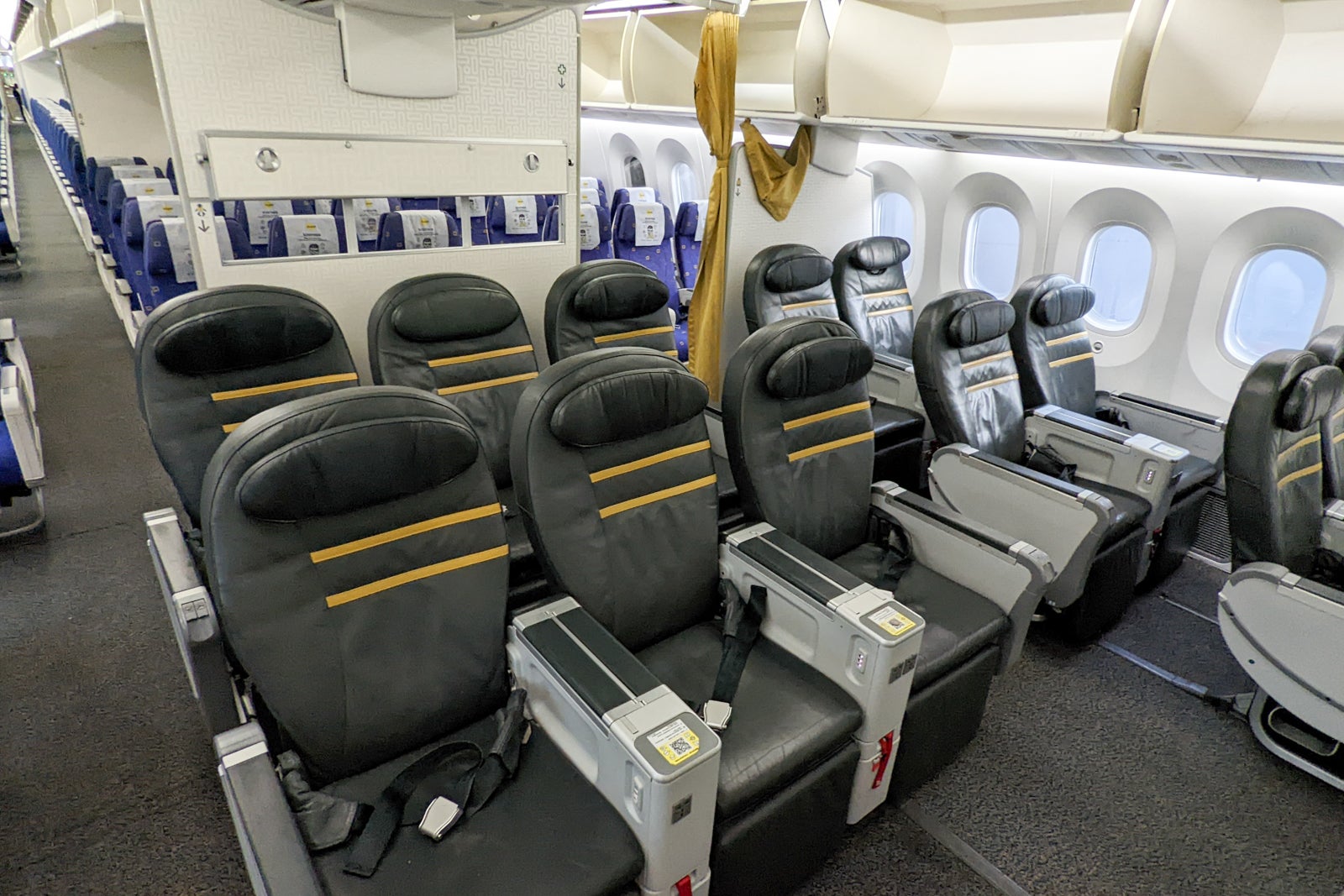
(Photo by Ben Smithson/The Points Guy)
The seat by manufacturer HAECO had 38 inches of pitch and 6 inches of recline, which is pretty standard for international premium economy seats (some have more recline). The real treat was the width: 22 inches felt positively roomy and more akin to a business-class seat than anything budget.
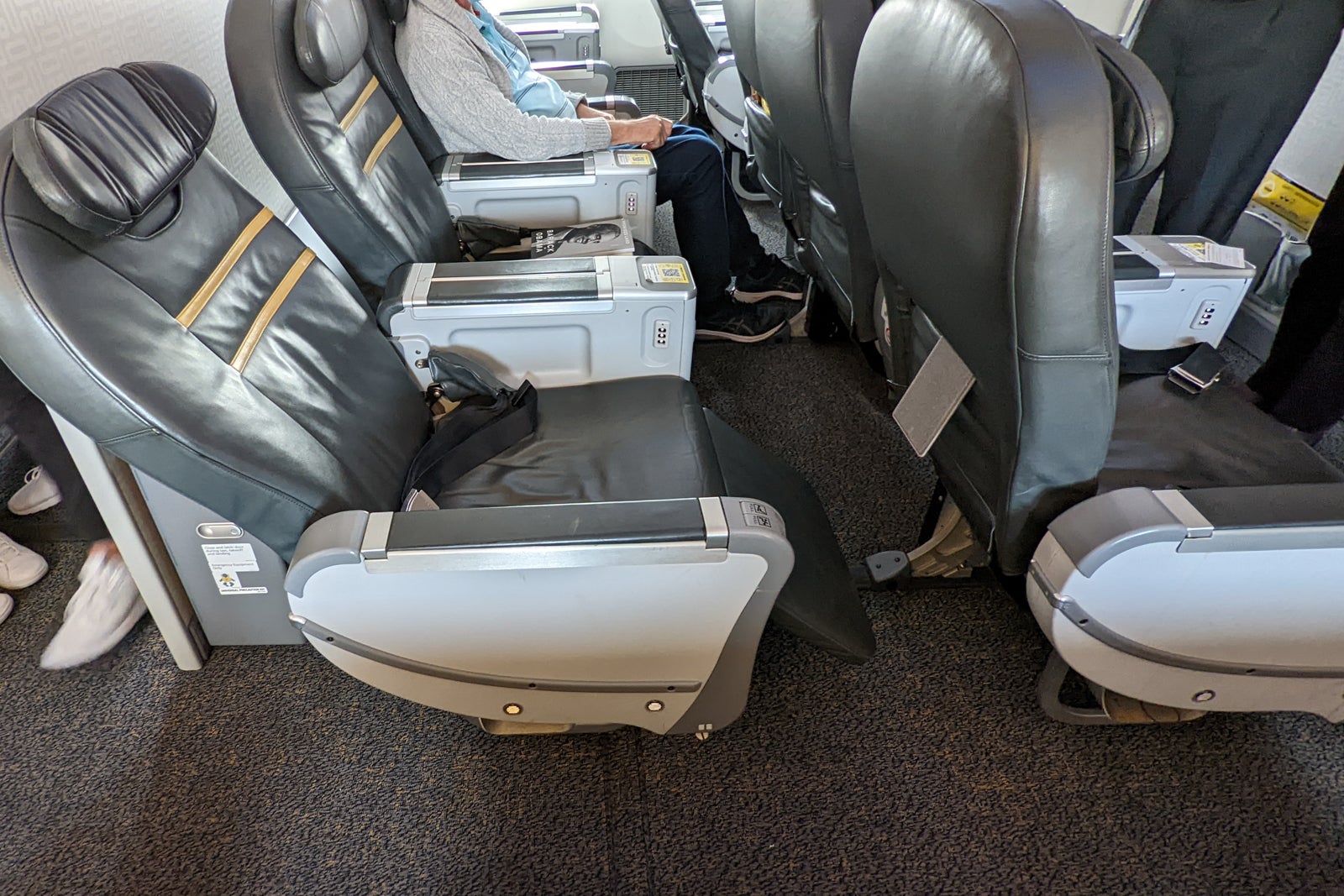
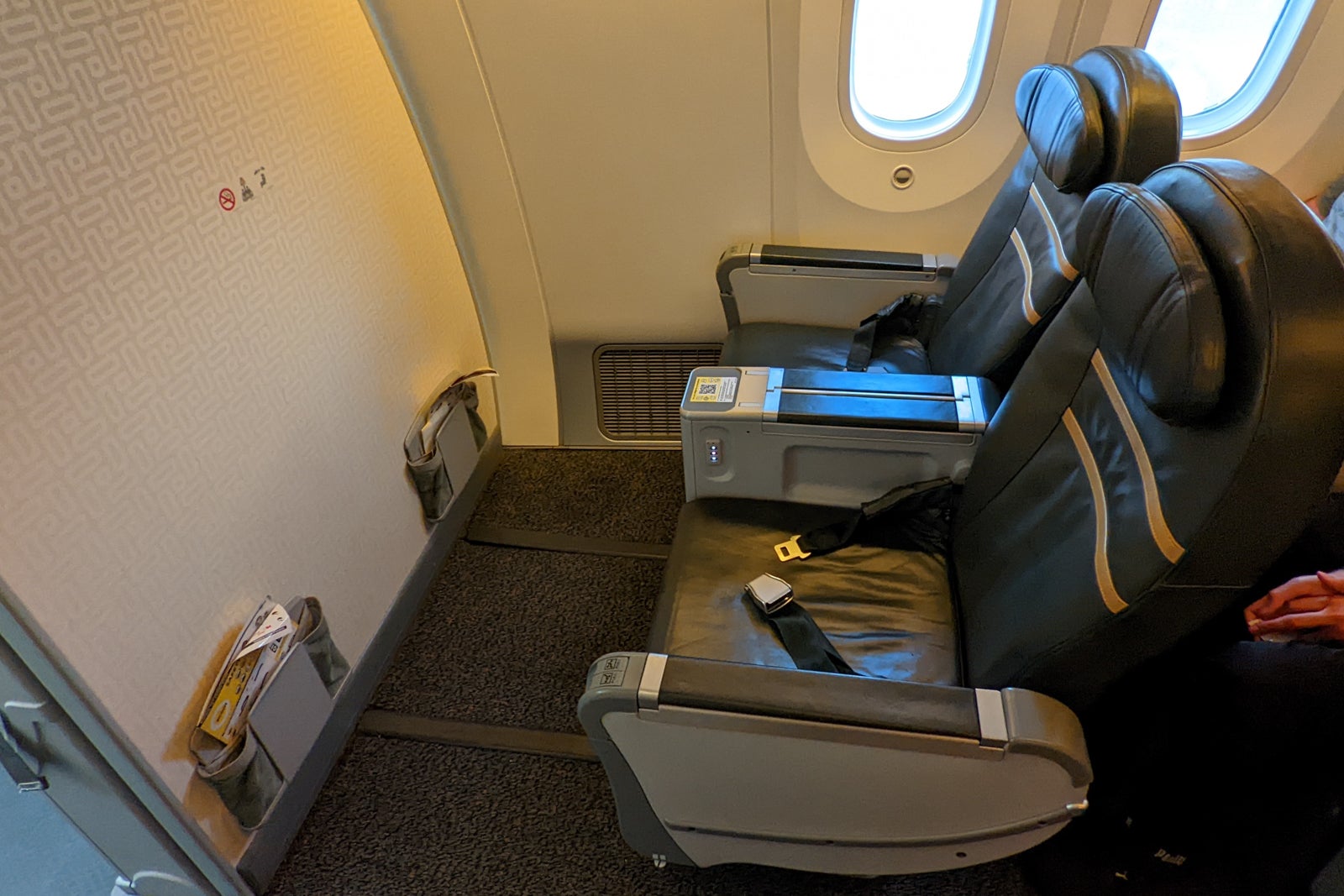
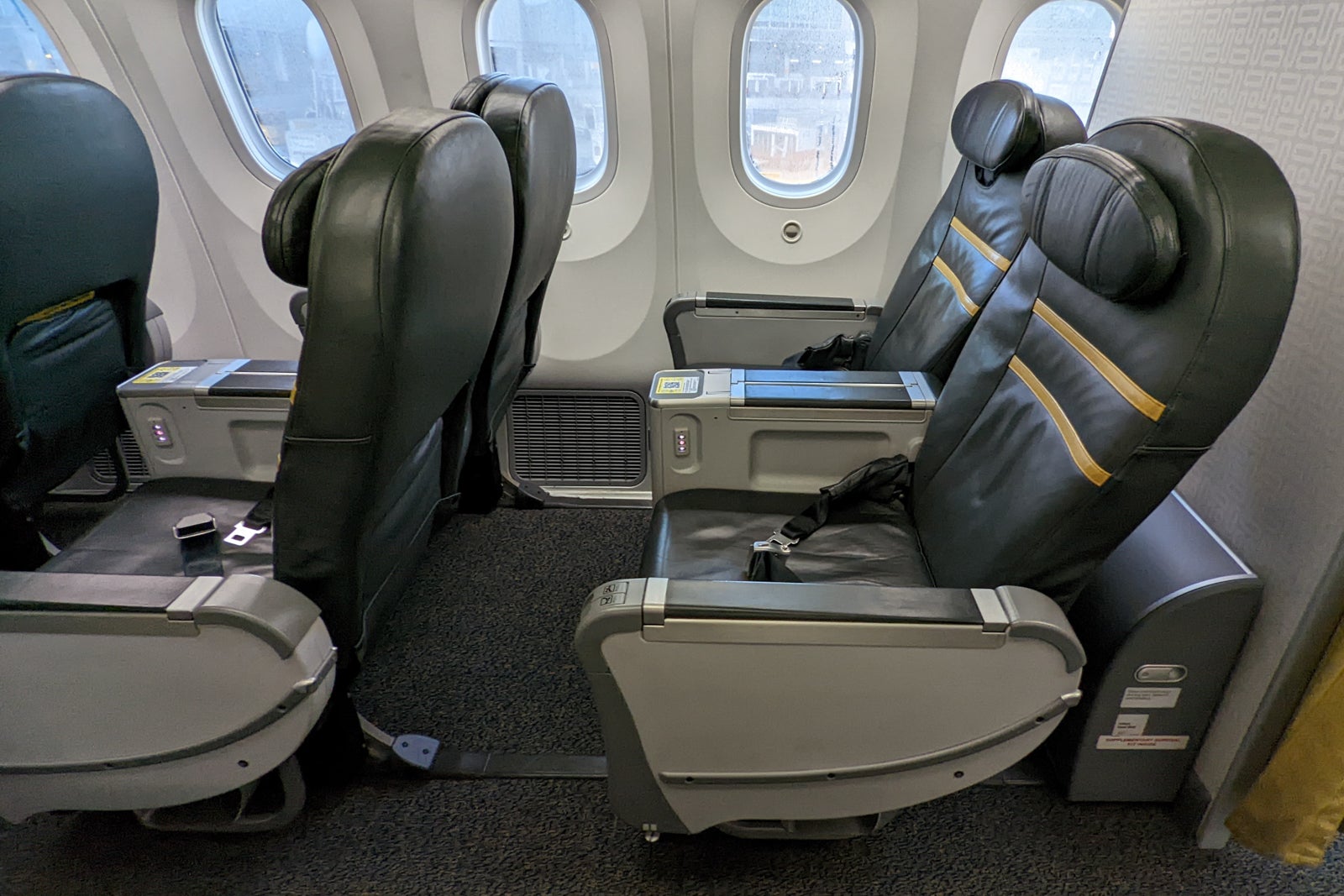
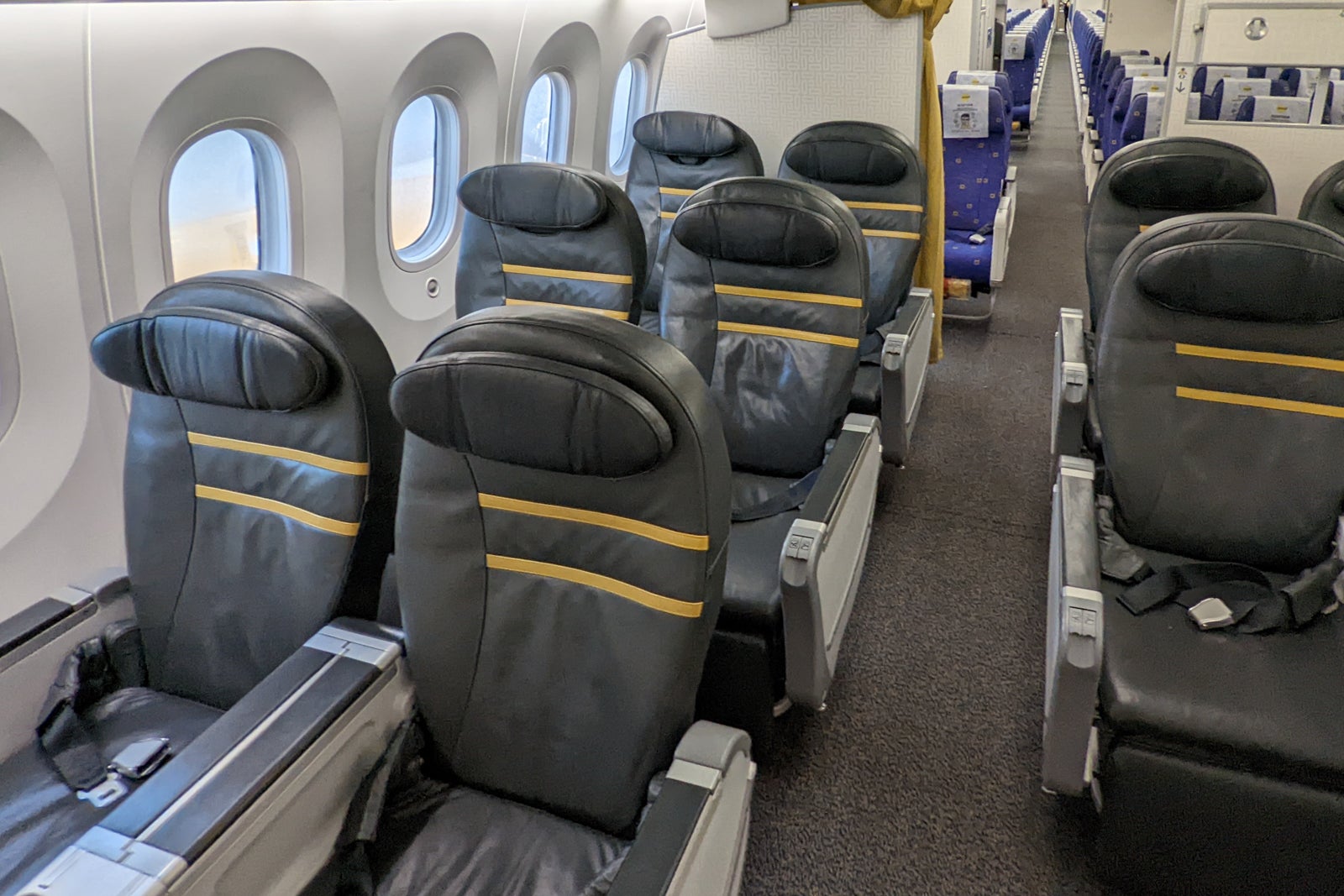
I had selected Seat 3F for the entire journey to London, an aisle seat in the second row of middle seats as I figured I would want aisle access on the long flight to stretch my legs. It wasn’t until I boarded that I realized seats 2D and 2F in the row in front of me are the best seats in the cabin because they have several inches more of legroom since there’s no row in front of them, as well as direct aisle access.
My first impression sitting in my ScootPlus seat was great. It was basically a big, comfy recliner, similar to domestic first-class seats on regional jets I’ve flown in the United States, and it felt noticeably more spacious and comfortable than any economy seat I’ve ever experienced. I only slept for an hour or so on this daylight flight but found the seat worked well for a nap, especially with the adjustable headrest.
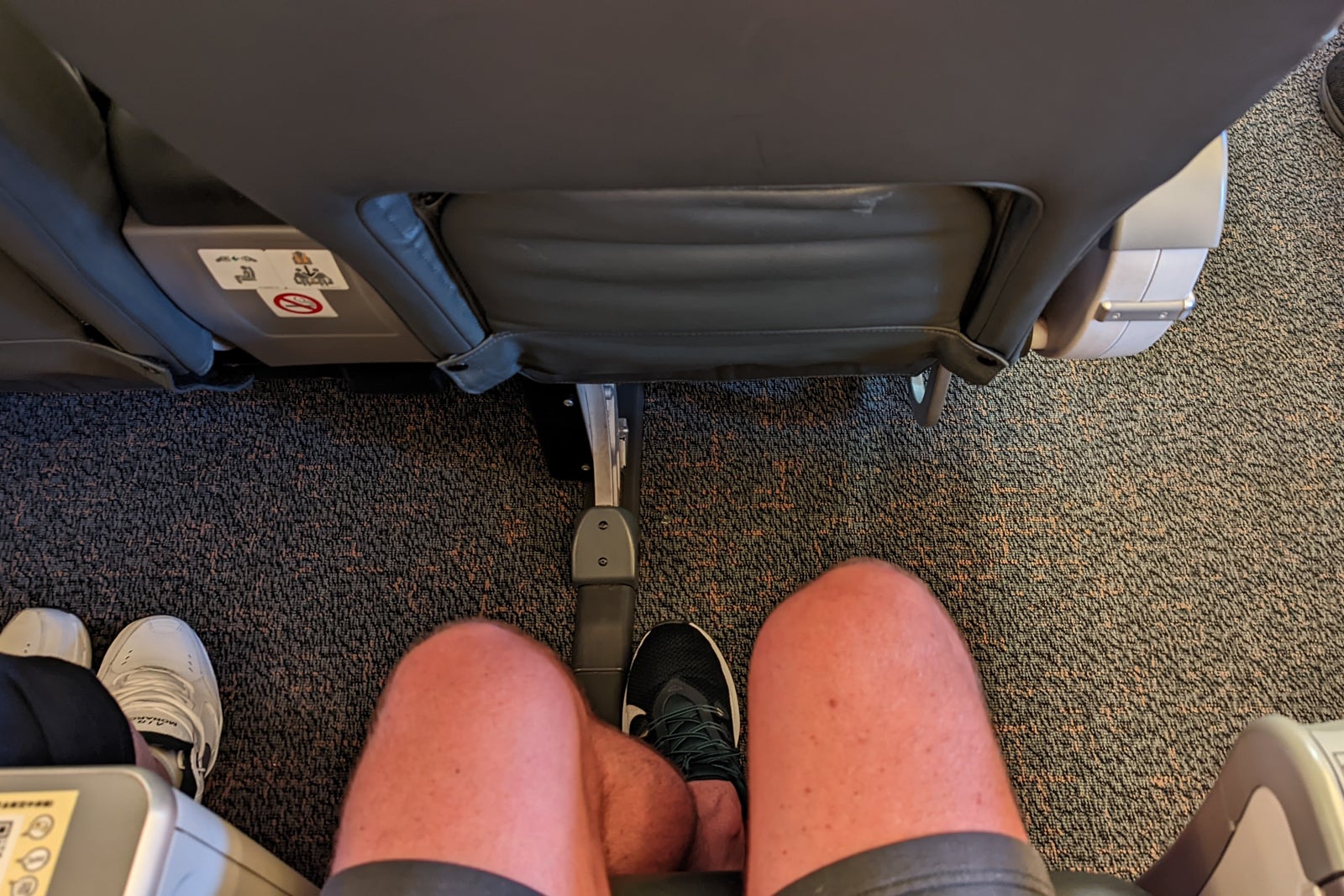
(Photo by Ben Smithson/The Points Guy)
I liked the padded leg rest, though I would have preferred if it had had a fold-down footrest, too, for even more support.

(Photo by Ben Smithson/The Points Guy)
My 15-inch laptop fit on the tray table that folded out from its non-aisle armrest and I could still use it while the passenger in front was fully reclined thanks to the generous legroom.
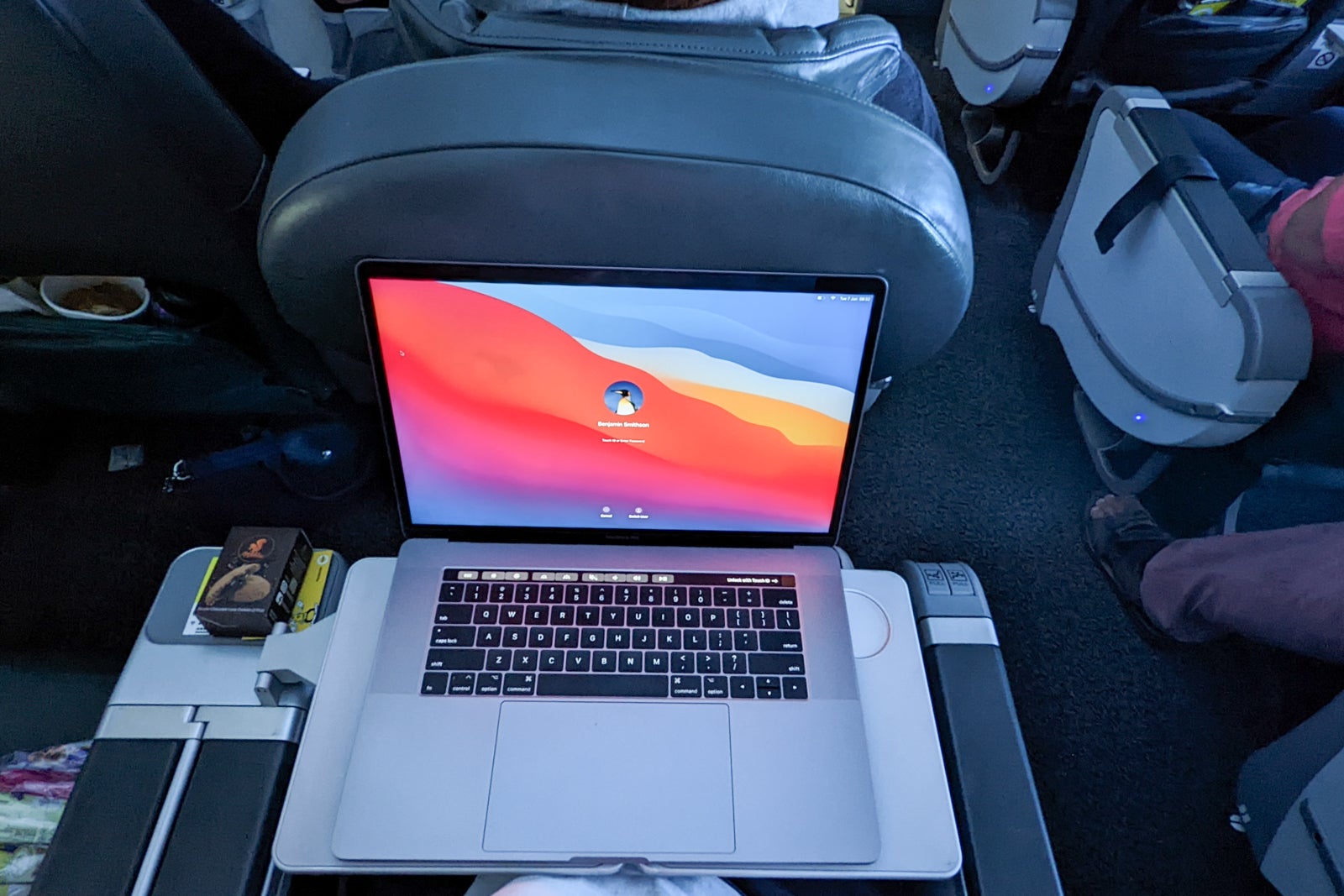
(Photo by Ben Smithson/The Points Guy)
While the seat was capacious, it was pretty basic otherwise. Scoot decided not to install any inflight entertainment screens, a decision I think was a mistake for an aircraft operating flight this long. A large literature pocket was the only storage option around the seat.
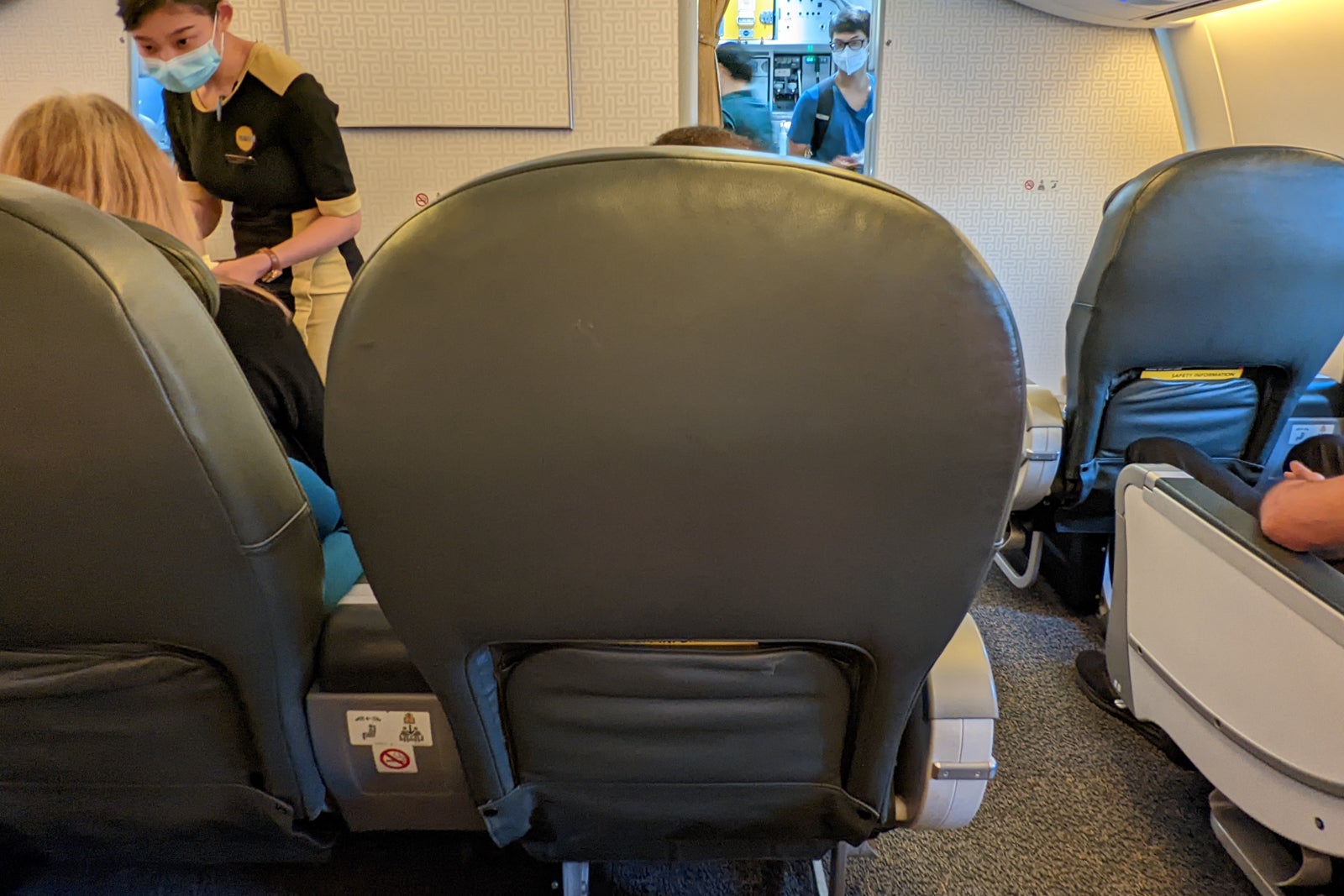
(Photo by Ben Smithson/The Points Guy)
A curtain separated the ScootPlus cabin from the rest of the aircraft, which really did give it an exclusive feeling that I was not expecting.
I was curious as to how the stop in Bangkok would work. Around two-thirds of the aircraft disembarked in Thailand, with instructions from the cabin crew that those continuing on to London should remain on board. The cleaning crew then arrived with a flurry of activity, creating a chaotic atmosphere as they vacuumed and wiped around us. In fact, I felt like I was in their way. They quickly left and a fresh crew, as well as hundreds of new passengers, boarded.
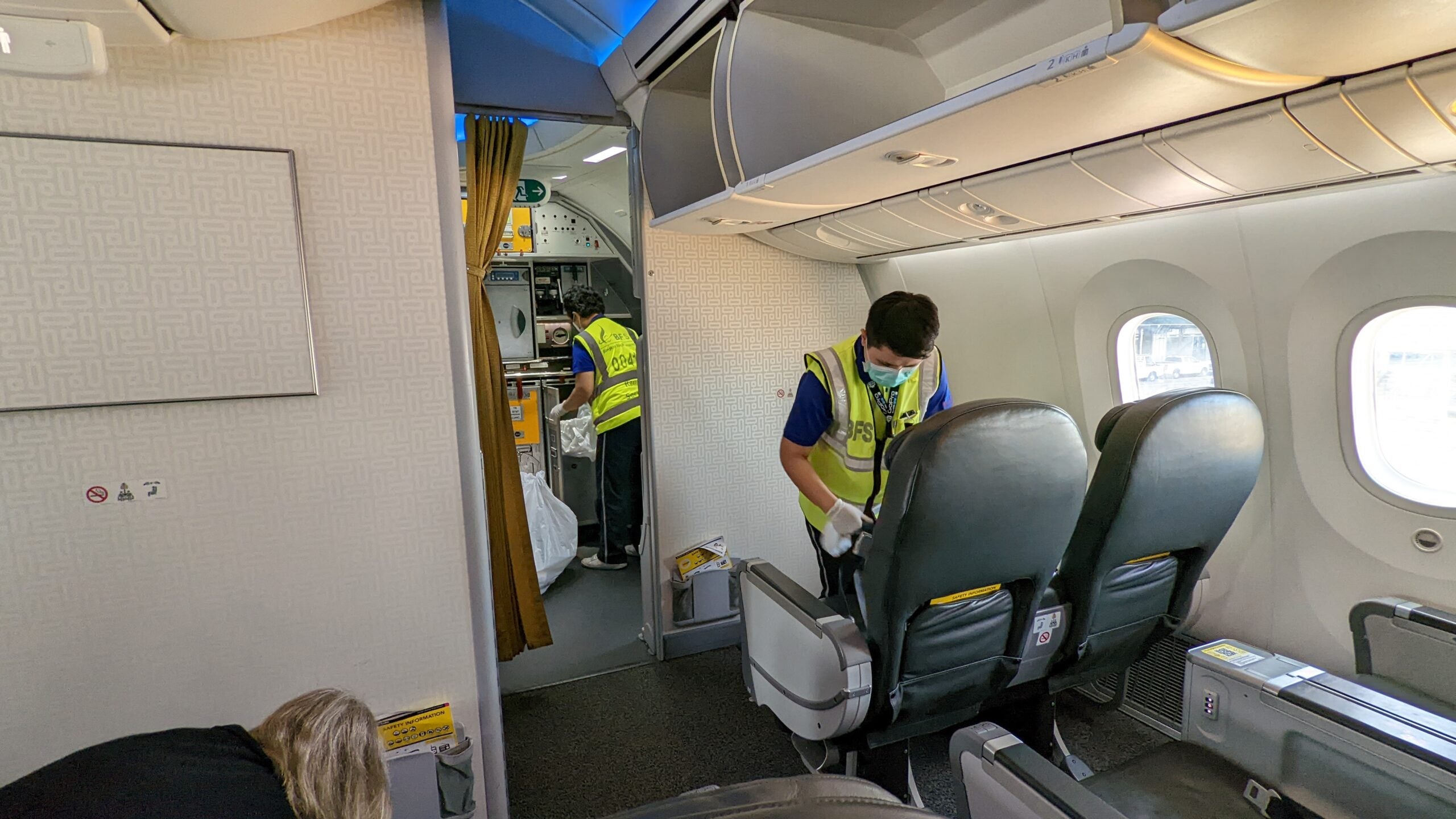
(Photo by Ben Smithson/The Points Guy)
Given how long the total journey was, I would have much preferred to use the 90-minute stop to disembark at the gate area, stretch my legs a little and then reboard with the new passengers.
menities and entertainmentThere was nothing waiting for me on my seat when I boarded, except a small cup of water. Shortly after takeoff, the crew delivered my pre-purchased Snooze Kit. The eye mask and neck pillow were good quality, though it wasn’t until I arrived home and had the space to spread out the scratchy, polyester blanket that I realized it was rather … bright.
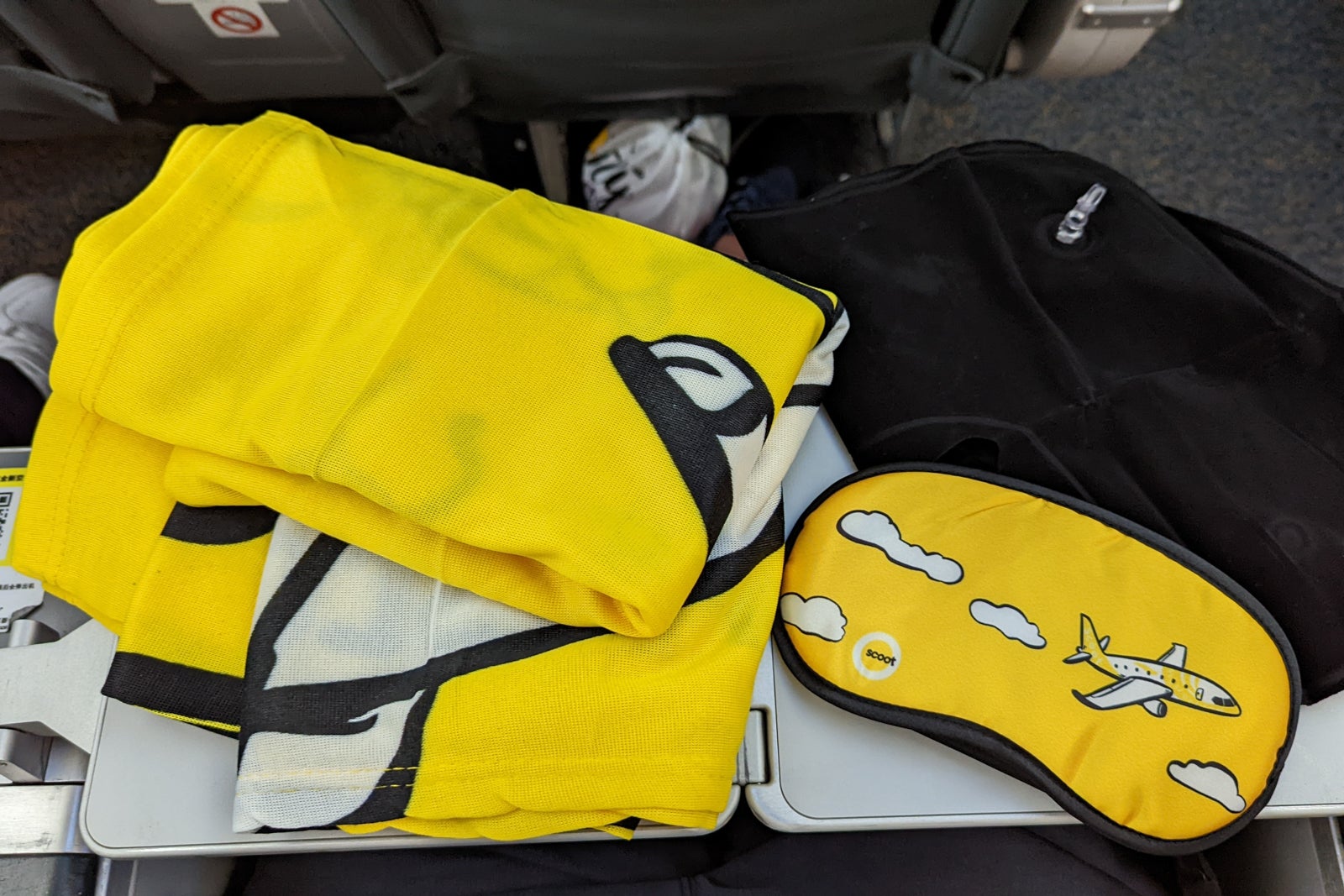
(Photo by Ben Smithson/The Points Guy)
It reminded me of a sponsor-branded giveaway flag for children, like a poster you could wrap yourself in.
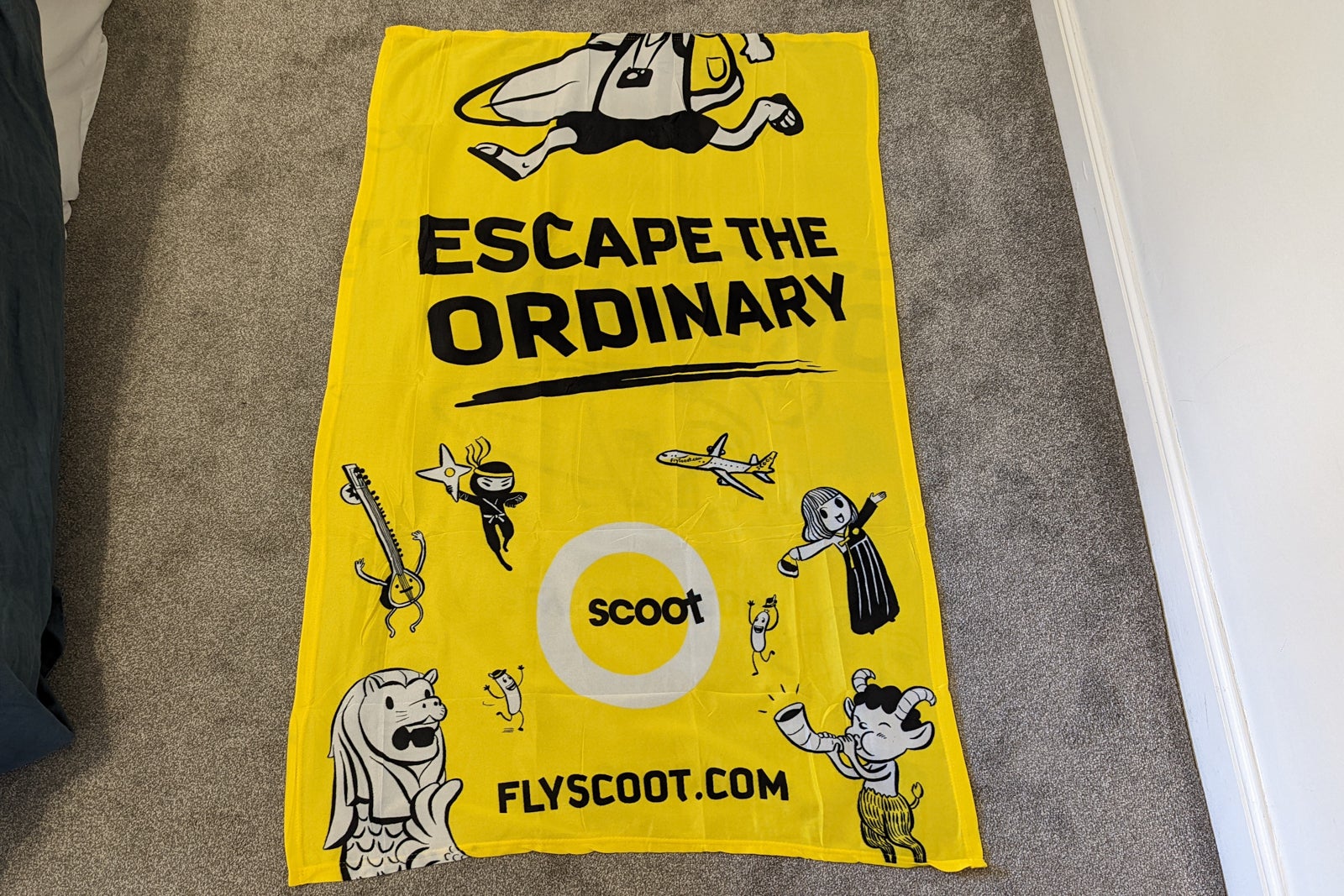
(Photo by Ben Smithson/The Points Guy)
All ScootPlus passengers were handed a card with a code for their 30MB of complimentary Wi-Fi. Virtually every passenger struggled to connect, myself included, as the service was constantly displaying as “Connected, but not available right now” for several hours. I eventually managed to connect through a non-Chrome browser (try Safari), but the 30MB only lasted a few minutes.
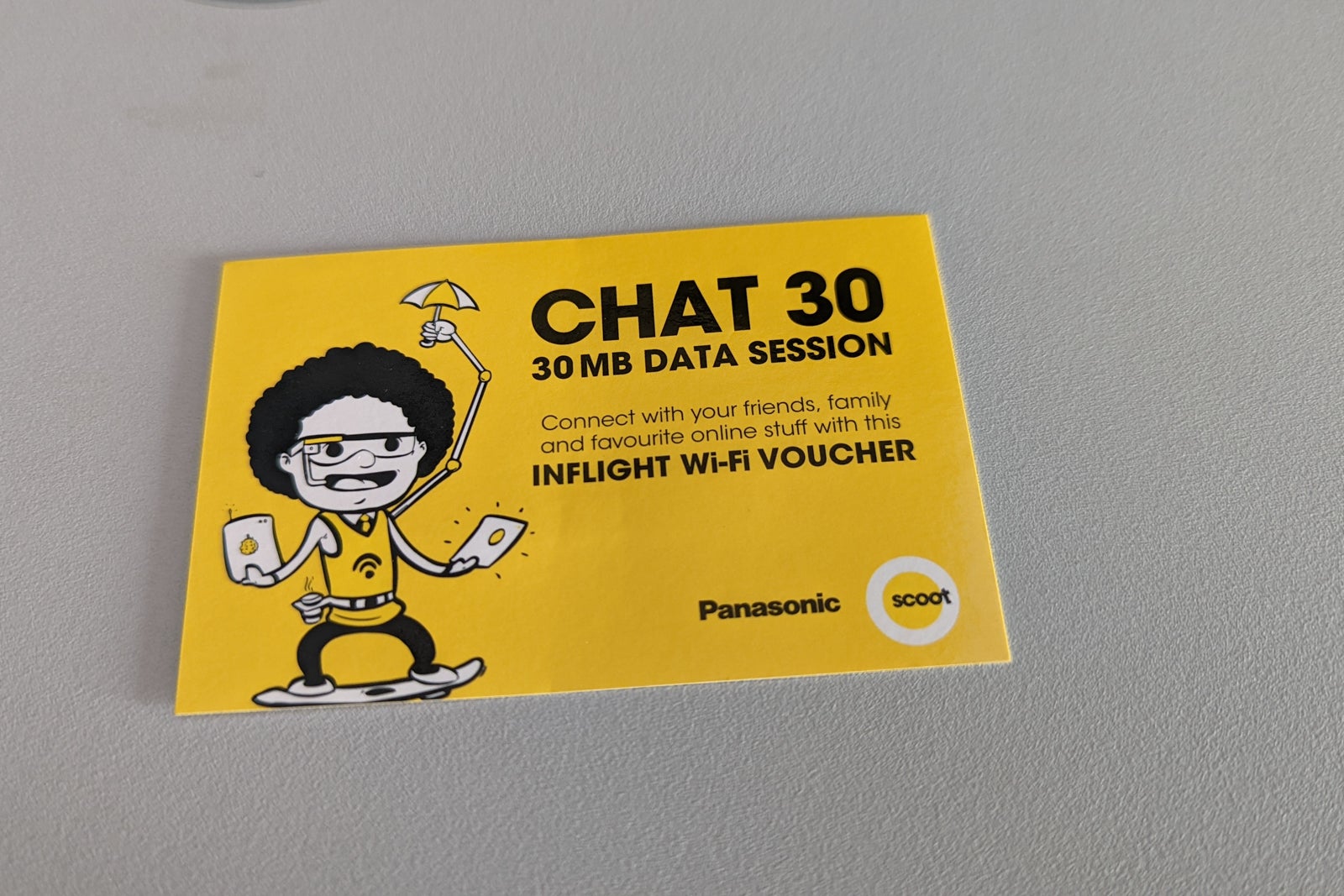
(Photo by Ben Smithson/The Points Guy)
I then moved on to my 200MB of pre-purchased data, which at least lasted a few hours with reasonable speeds of about 10Mbps download. A second and third pack of 200MB for SG$41 ($30) lasted less than 90 minutes each. Although I still had five hours of flight left, after already spending $90 on Wi-Fi for normal work activities like emails, Slack messages and writing in WordPress (no streaming videos or music or Zoom calls) I gave up.
Scoot should offer full-flight packages of Wi-Fi on trips of this length, especially if they do not want to install inflight entertainment screens, though there’s no telling how expensive those would be.
In-seat power points were available, though they had to be shared with my neighbor. Passengers in the economy cabins were forced to pay SG$5 ($3.60) to use their power points, which is one of the stingiest measures I’ve ever seen on a plane, though fortunately the luxury of electricity was provided to ScootPlus passengers at no extra cost.
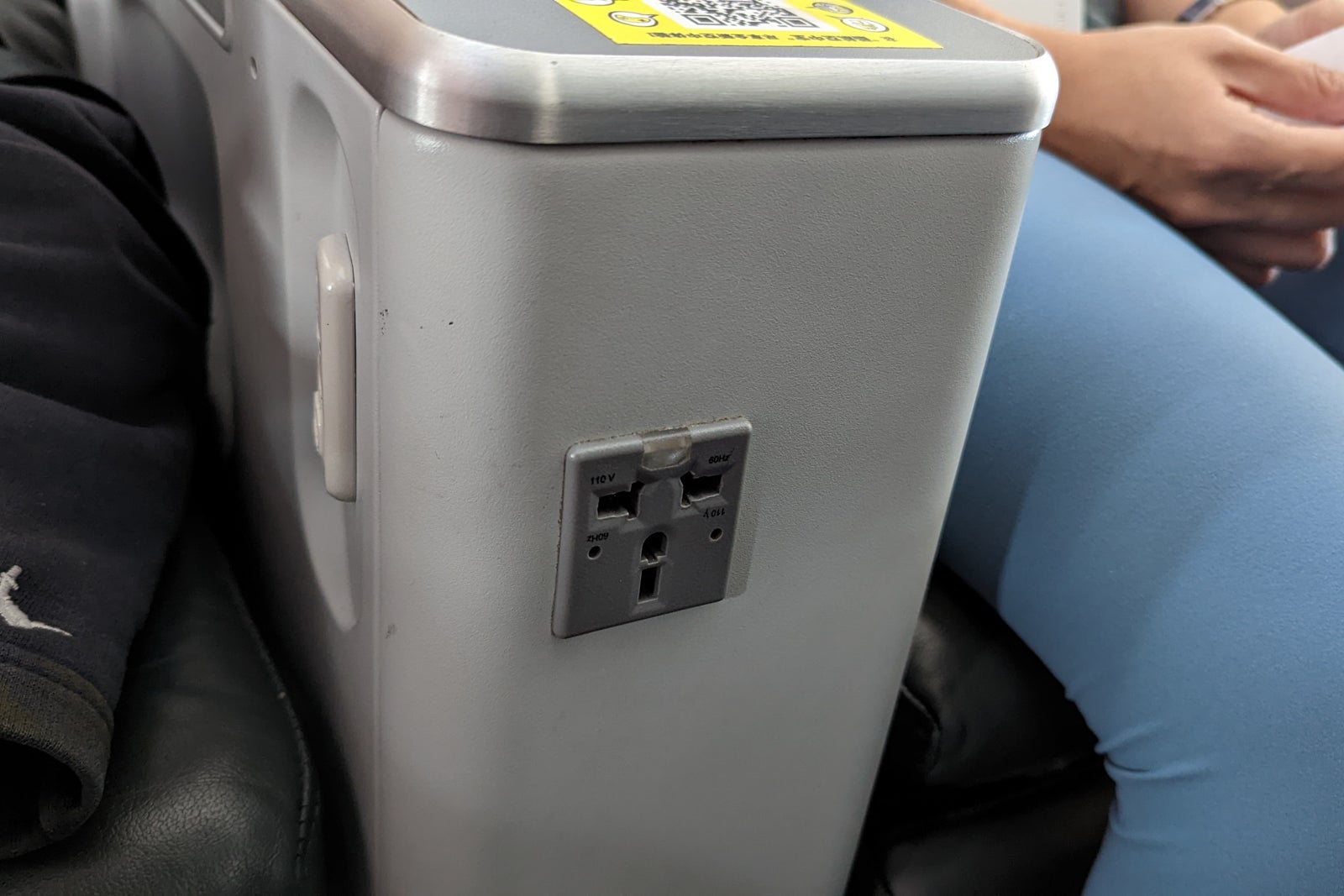
(Photo by Ben Smithson/The Points Guy)
There was a dedicated bathroom at the front of the aircraft for ScootPlus passengers which rarely had a line considering the cabin seated just 18 passengers. It was kept very clean by the hardworking crew throughout the trip.
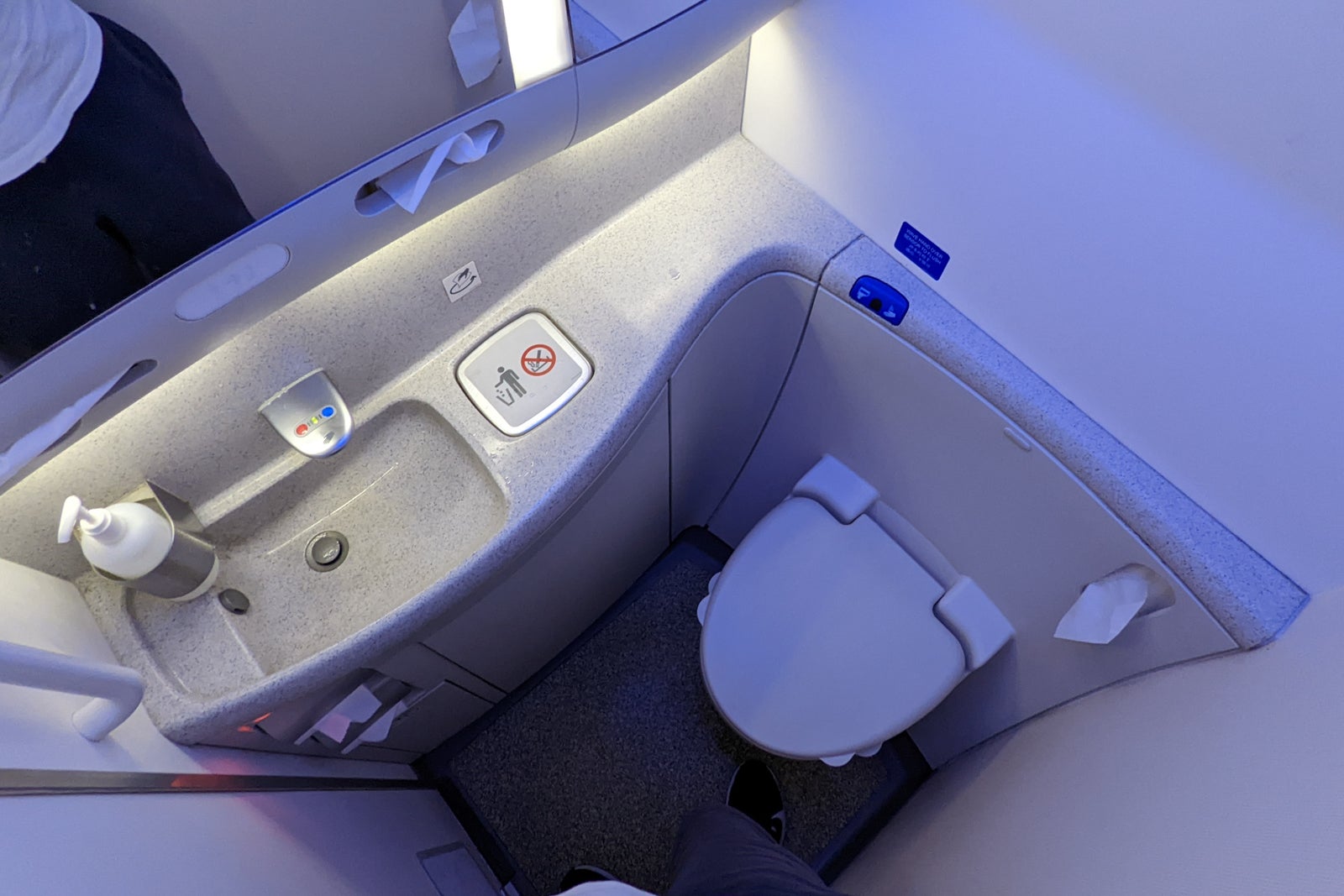
(Photo by Ben Smithson/The Points Guy)
Food and beverage
A sealed cup of water was waiting on each ScootPlus seat — I hadn’t seen water served like that since I was a child and it reminded me of flying Singapore Airlines many decades ago.
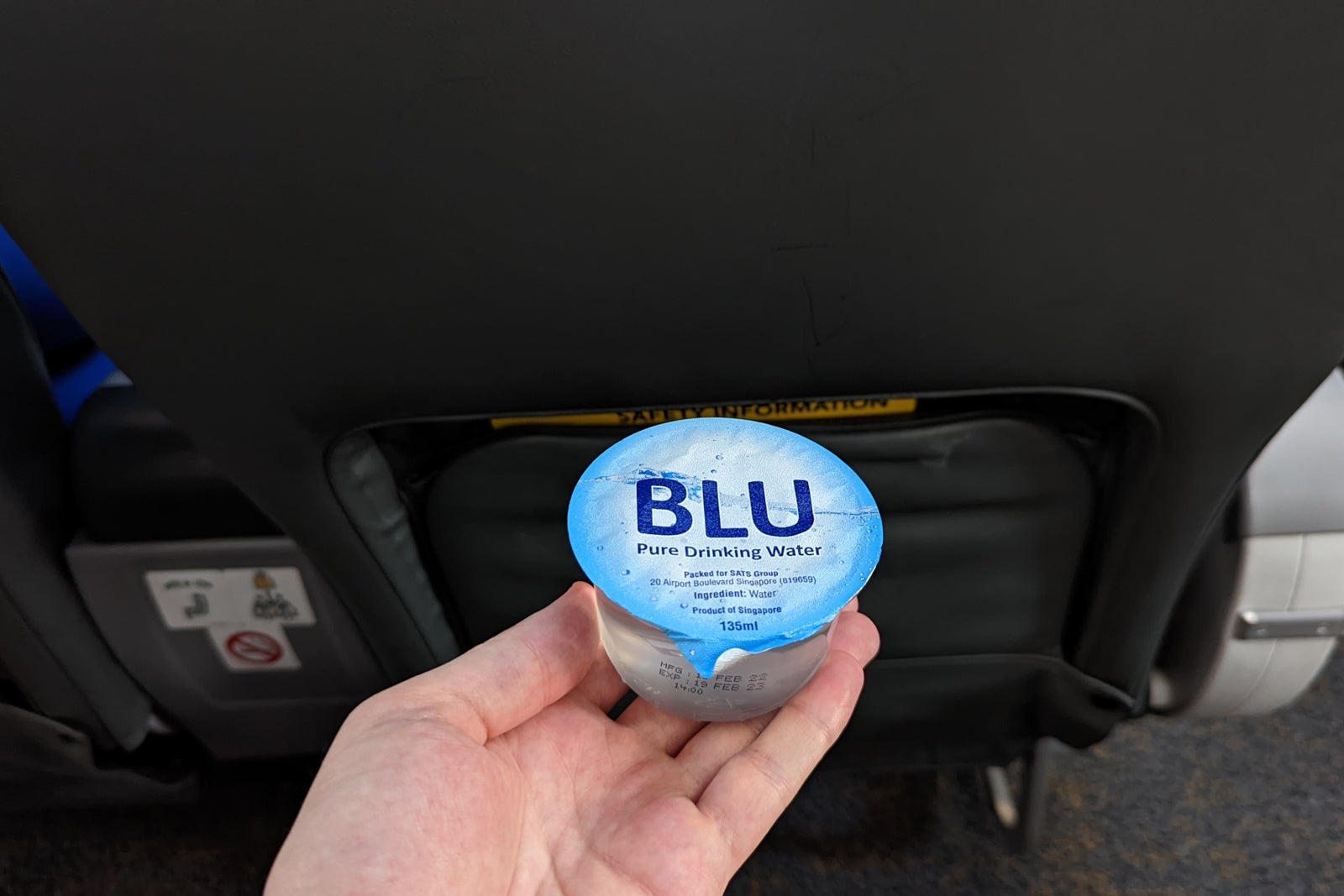
(Photo by Ben Smithson/The Points Guy)
Shortly after takeoff from Changi, the crew came around to serve all passengers their preordered first meal. I had chosen chicken with mixed brown rice, which arrived like a TV dinner, still sealed with a plastic film on top. I could see the sauce inside and had to painstakingly peel off the lid with the steady hand of a cardiovascular surgeon to avoid spilling the boiling hot liquid all over me (a white shirt was a poor choice for this flight).
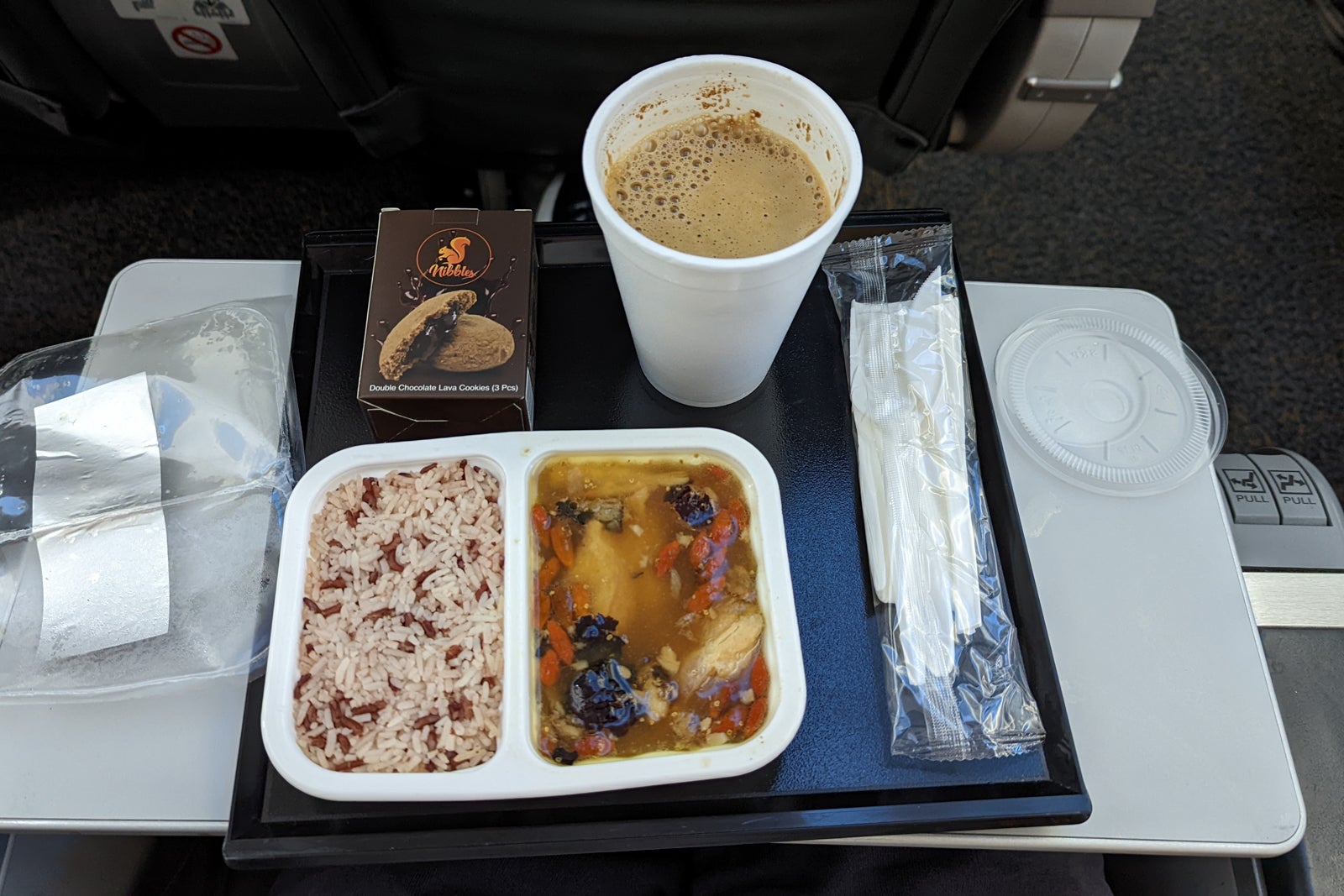
(Photo by Ben Smithson/The Points Guy)
The chicken had some mystery black items floating in it but tasted OK, even if it was an odd choice for breakfast. I was also offered my choice of a cold or hot nonalcoholic drink. I chose the hazelnut white coffee, which was a powdered concoction, far heavier on sugar than coffee. There was also a box of chocolate cookies for dessert, again unusual for 8 a.m.
Before we landed in Bangkok, all ScootPlus passengers continuing on to London were handed a snack pack consisting of a can of Coca-Cola, a banana muffin, a sachet of Milo, a can of Pringles and a croissant. While nothing gourmet, it was an unexpected surprise and a nice gesture for this long journey.

(Photo by Ben Smithson/The Points Guy)
After takeoff on the second leg from Bangkok, the crew advised us that we would be served our second and final meal immediately. This was met with surprise and protest from passengers, both those traveling from Singapore who had eaten their last meal just two hours earlier and those who had just joined in Bangkok and were expected to make one meal sustain them for 13 hours.
The crew relented and offered to serve passengers on demand. I chose to have my second meal around four hours into the flight, which consisted of a preordered nasi lemak, a typical Malaysian dish I had enjoyed on previous visits to Asia.

(Photo by Ben Smithson/The Points Guy)
Unfortunately, this was probably the worst nasi lemak I had ever eaten. As I peeled off the plastic film the tray underneath was mostly a block of plain white rice, with a small amount of meat that looked and smelled processed beyond recognition. It tasted pretty terrible, too, with the clumpy, dry sauce falling off each chunk of meat as I picked it up with my fork.
For my included beverage this time, I opted for a can of Coca-Cola, which was served with ice. The same cookies were served with the second meal as the first.
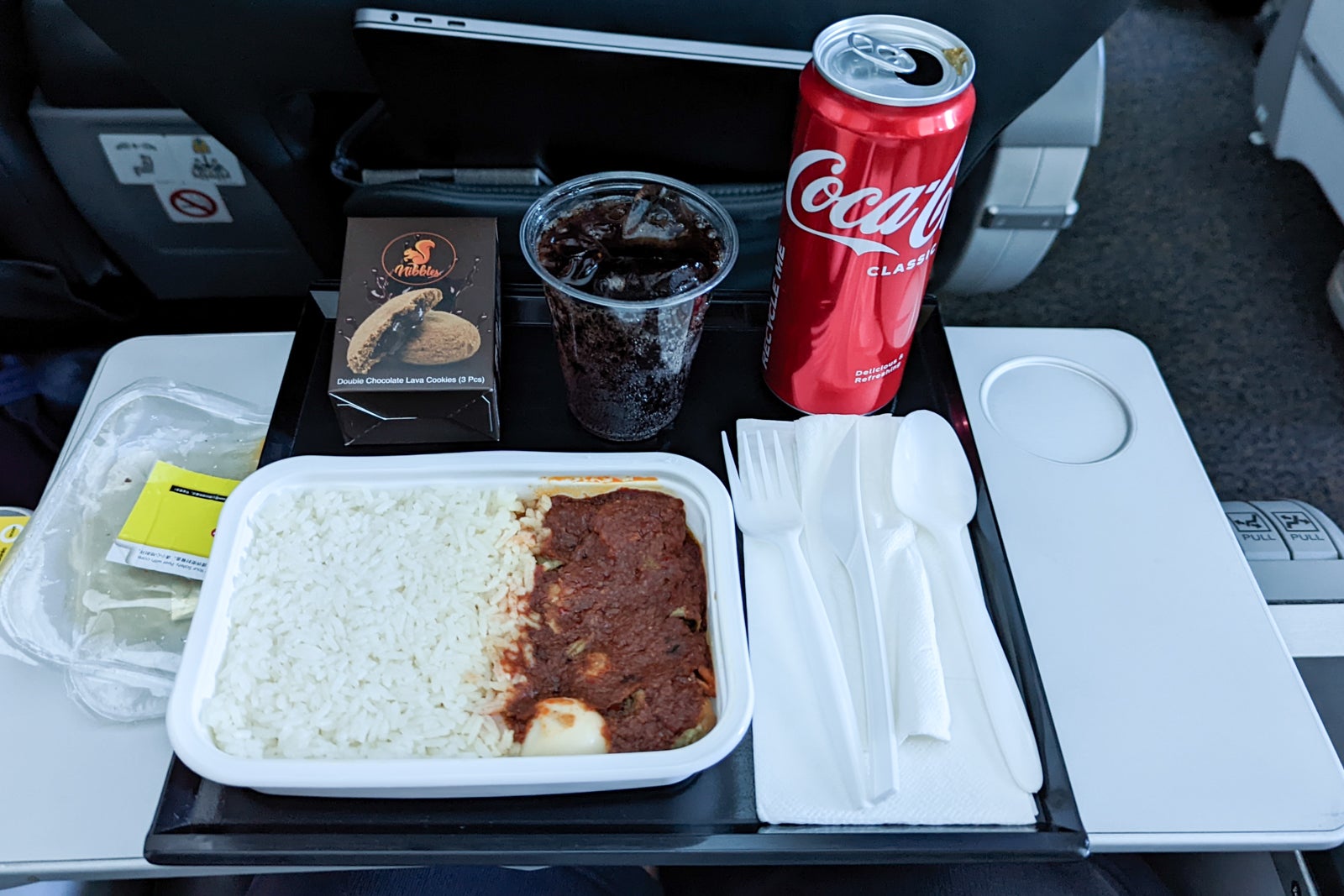
(Photo by Ben Smithson/The Points Guy)
Five hours after my second meal, and with four hours still to fly, I was hungry again. ScootPlus passengers are only provided with one complimentary meal per sector — everything else must be purchased. I tracked down a menu that was only a range of the same microwave meals I had already eaten and some snacks. I didn’t particularly enjoy either of the first two hot meals so wasn’t keen to spend another SG$12 ($8.60) on a third.

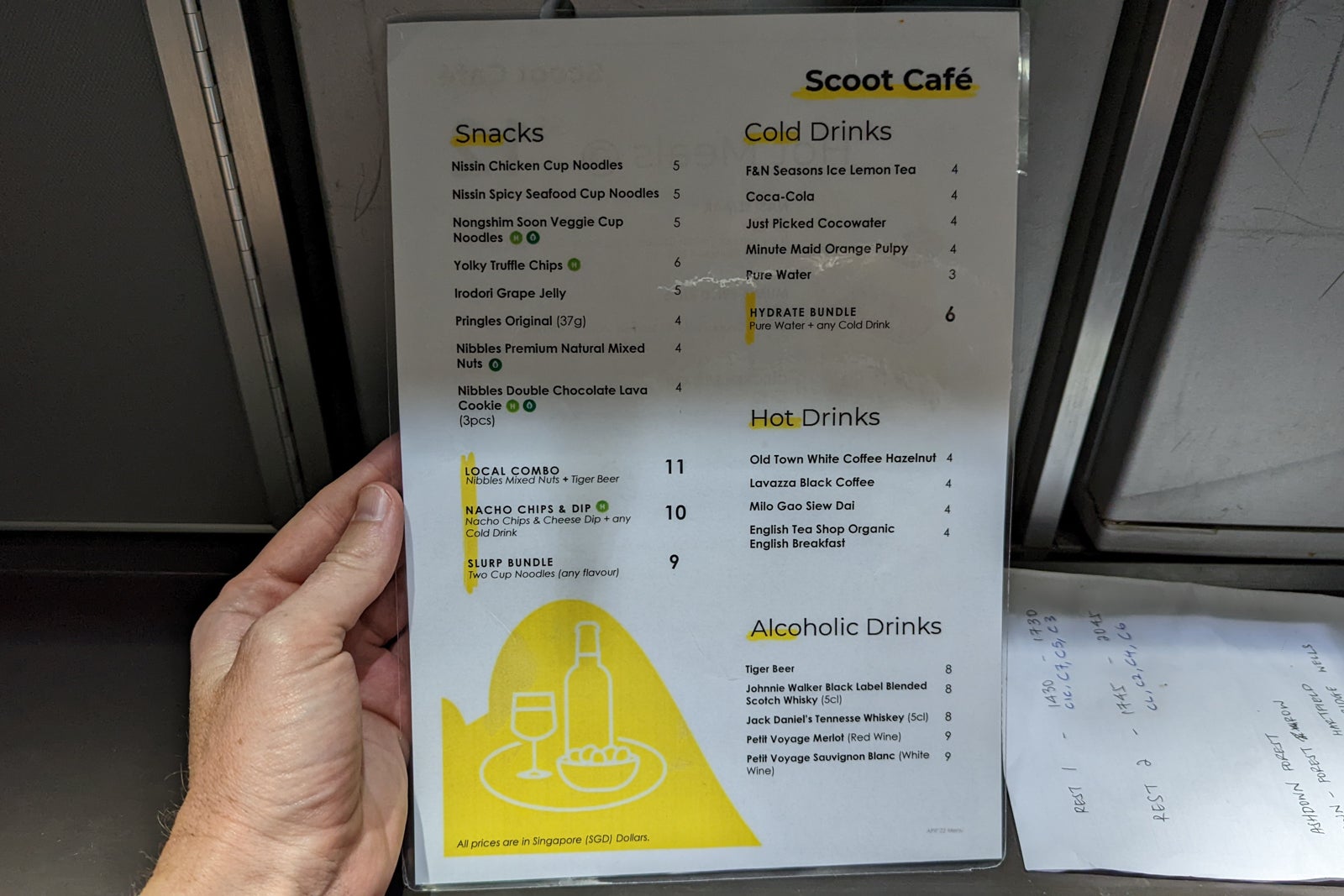
There wasn’t a lot that excited me on the snack menu, so I settled on a cup of chicken-flavored Nissin Cup Noodles (SG$5, $3) and some truffle potato chips (SG$6, $4.31). These were served with a free glass of water (ice had run out by this stage). Paying for ramen noodles was a stark reminder this was a budget carrier.
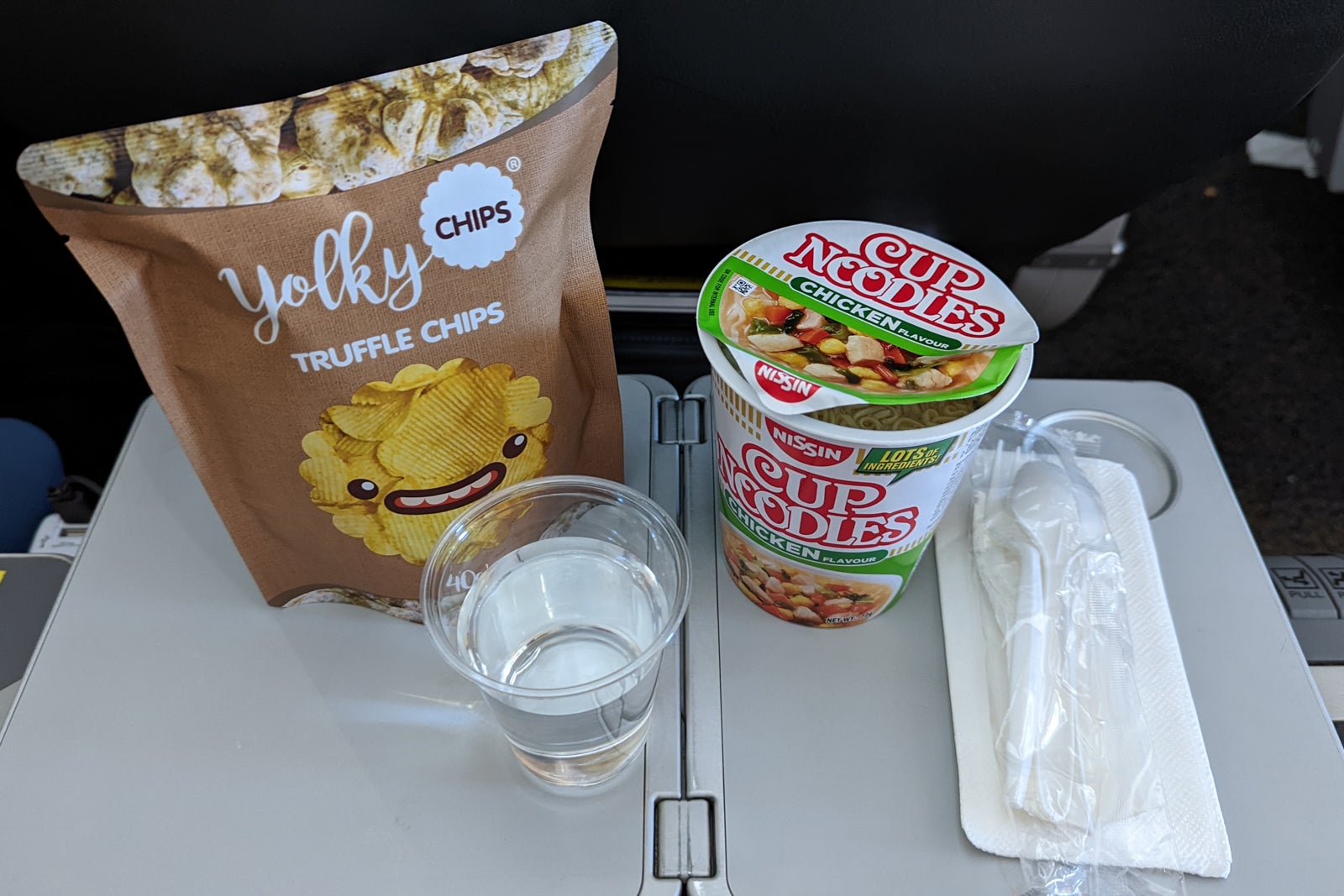
(Photo by Ben Smithson/The Points Guy)
Service
I cringed during boarding when I heard the crew on this flight referred to as “your Scooties,” which sounded like a troupe of amateur children’s performers. This was a world away from the glamorous “Singapore Girls” in their iconic kebaya uniforms, a symbol of Singapore Airlines for over 50 years.
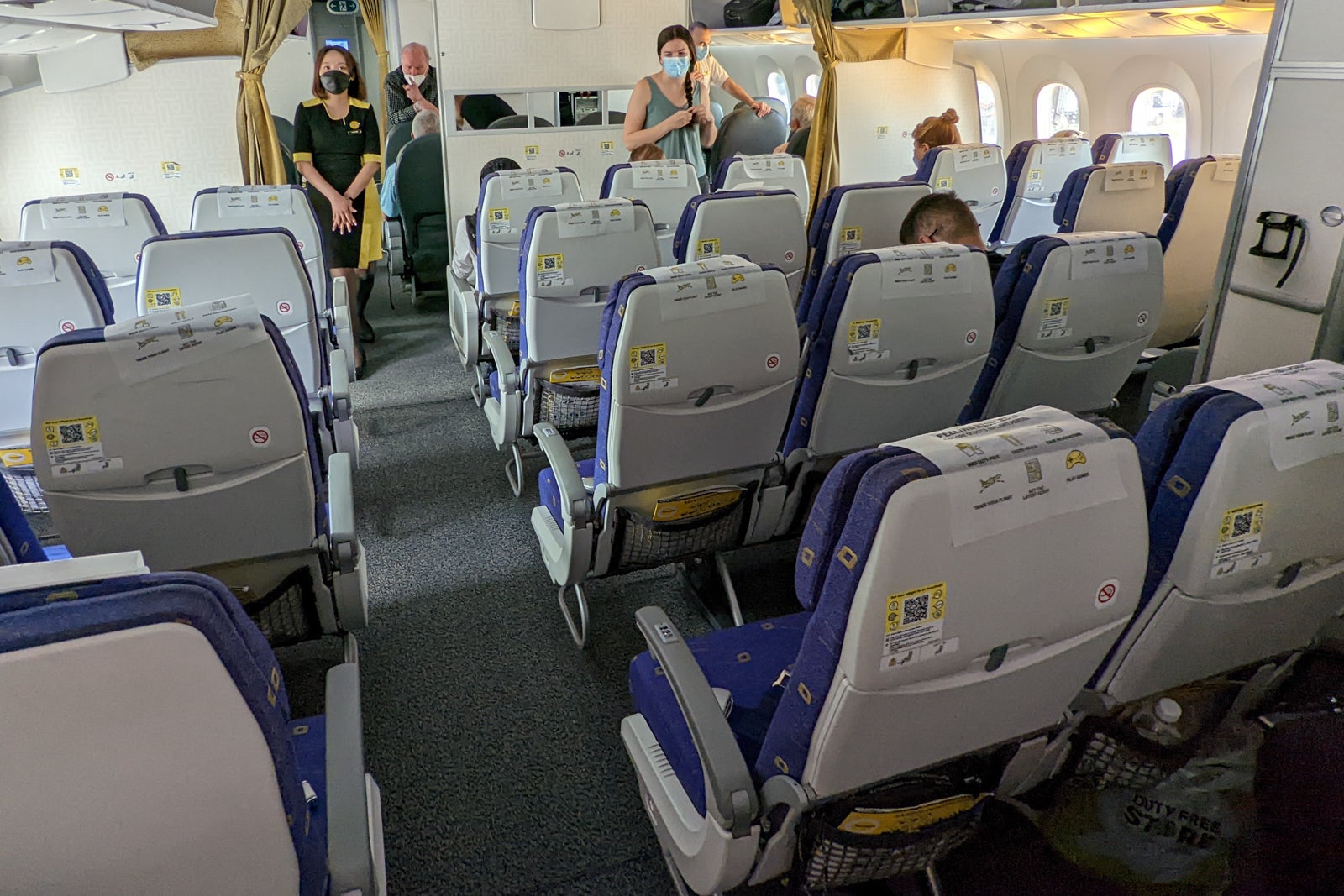
(Photo by Ben Smithson/The Points Guy)
However, the crew was fantastic during the entire journey. With over 300 bored passengers and no inflight entertainment screens, not to mention exorbitantly priced Wi-Fi, the crew had plenty of requests on their time, with call bells regularly dinging like church bells. Many passengers struggled to connect to the temperamental Wi-Fi and the crew patiently helped each person, even adjusting the settings on their personal electronic devices.
There was nothing low-cost about their sincerity or professionalism.
The pilot came into the ScootPlus cabin during the Bangkok stop and was very friendly and jovial, patiently answering passengers’ questions about the aircraft and airline.
Overall impression
There was a lot to like about ScootPlus: reasonable one-way fares, hardworking crew members and spacious seats with dimensions that would be acceptable in any legacy carrier’s premium economy cabin and were really comfortable to sit, lounge and nap in. Comparing seats only, I prefer this to Singapore Airlines’ premium economy seat.
Related: Footrests and fine dining: Manchester to Houston in Singapore Airlines A350 premium economy
So why would I not repeat this experience?
While I had thought a 15-hour flight entirely in daylight would be a savvy, productive and jet lag-fighting way to travel, it produced some unique and unexpected problems for me.
With windows left fully undimmed the entire flight, I only slept for about one of the 15 hours, leaving an awful lot of time to entertain myself. My fellow passengers, with whom I ended up chatting for many hours, admitted the same issue.
Scoot’s decision not to install inflight entertainment screens means passengers are quite literally left to their own devices. I managed to pass several hours reading, but when it came to my laptop, I wasn’t so lucky. Remember that in-seat power points are shared between seats, and you’ll need to negotiate battery life with your neighbor.
Even excluding the difficulties the cabin had connecting, the Wi-Fi was prohibitively expensive. I burned through my three packages ($90 in total) in five hours just doing normal work and gave up after that. I couldn’t justify the price. I wish Scoot sold entire flight packages with no data caps. Even priced at $50, I would have gladly purchased this to pass the time as there was little else to do across an entire waking day.
Finally, the food was mediocre at best, in terms of variety, presentation and taste. Flying is one of my favorite things to do, but I’ve rarely been so keen to get off a plane as I was after this flight.
While overnight flights may not induce a full night’s sleep sitting up, at least they might pass the time faster. And I would happily fly Scoot on a midhaul flight to Australia or Japan. But for a marathon journey entirely in daylight, I would pick a different carrier with more ways to pass the time that wouldn’t make the flight feel so incredibly long.
Featured photo by Ben Smithson/The Points Guy.
Title: 15 hours on a low-cost airline: Flying Scoot from Singapore to London
Sourced From: thepointsguy.com/reviews/scoot-plus/
Published Date: Tue, 21 Jun 2022 12:00:32 +0000
No comments:
Post a Comment